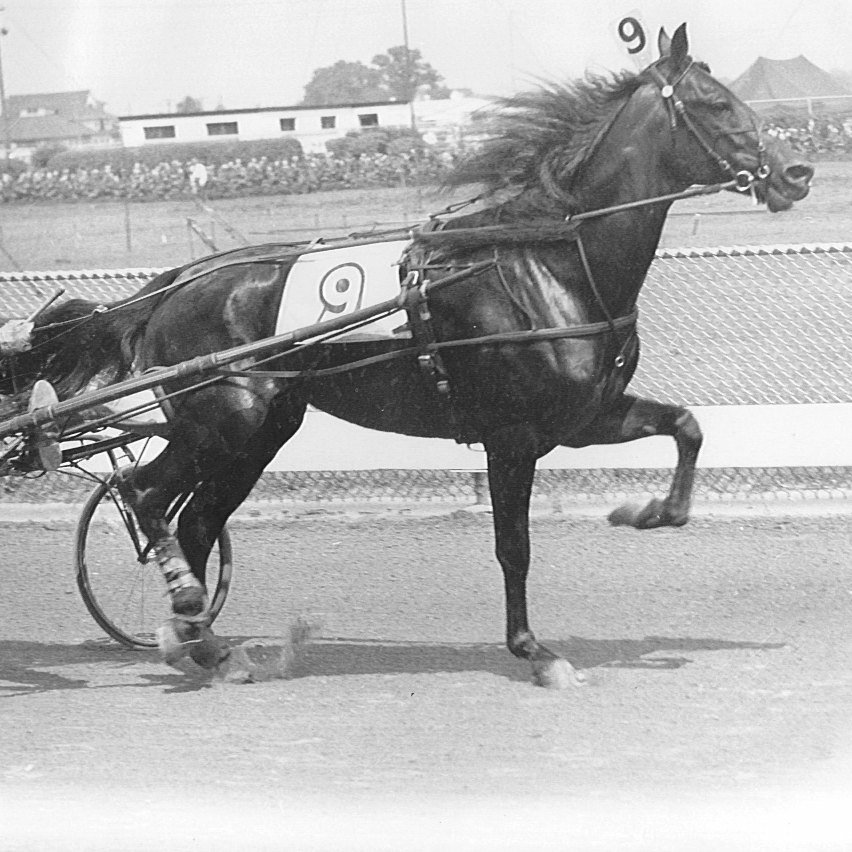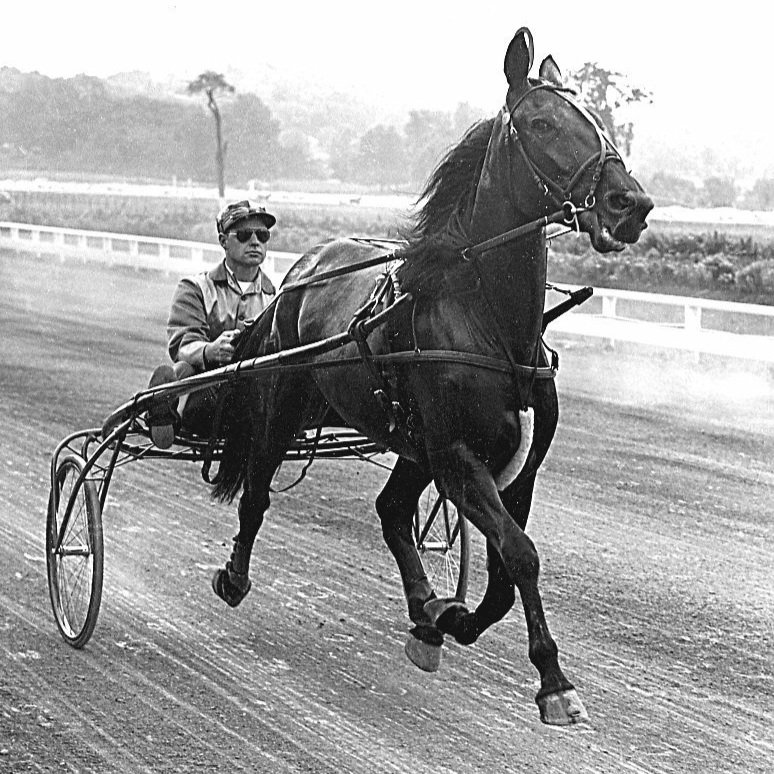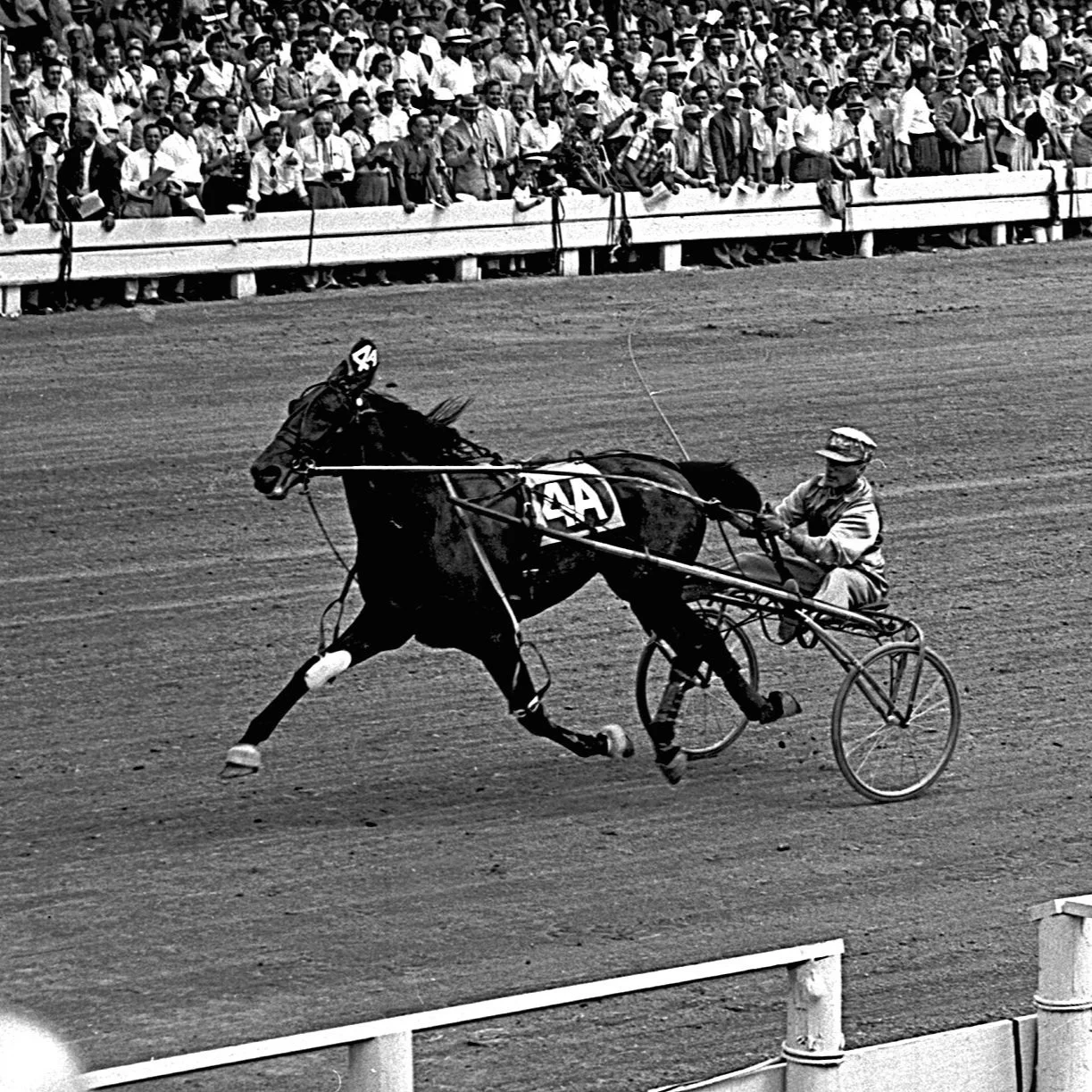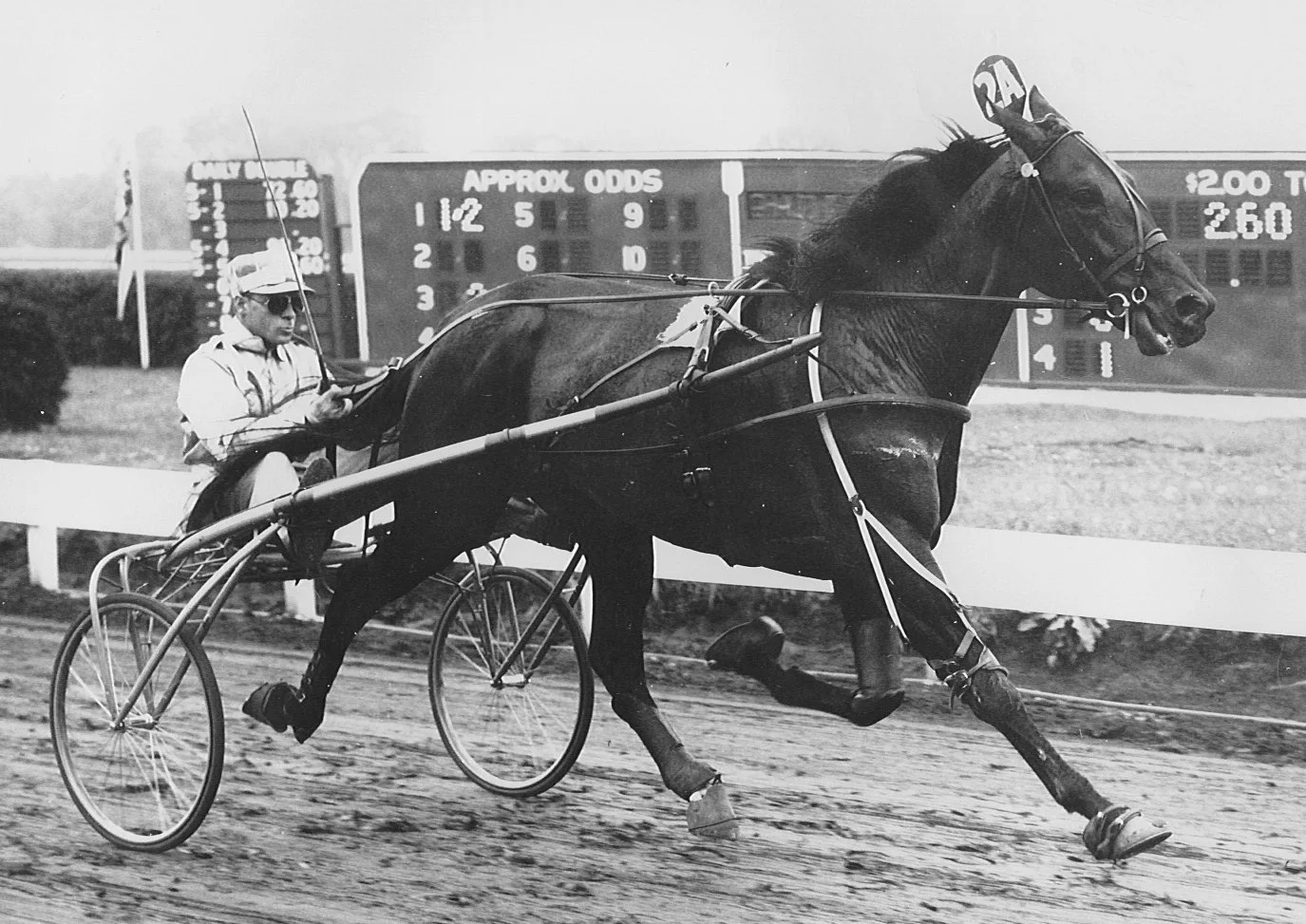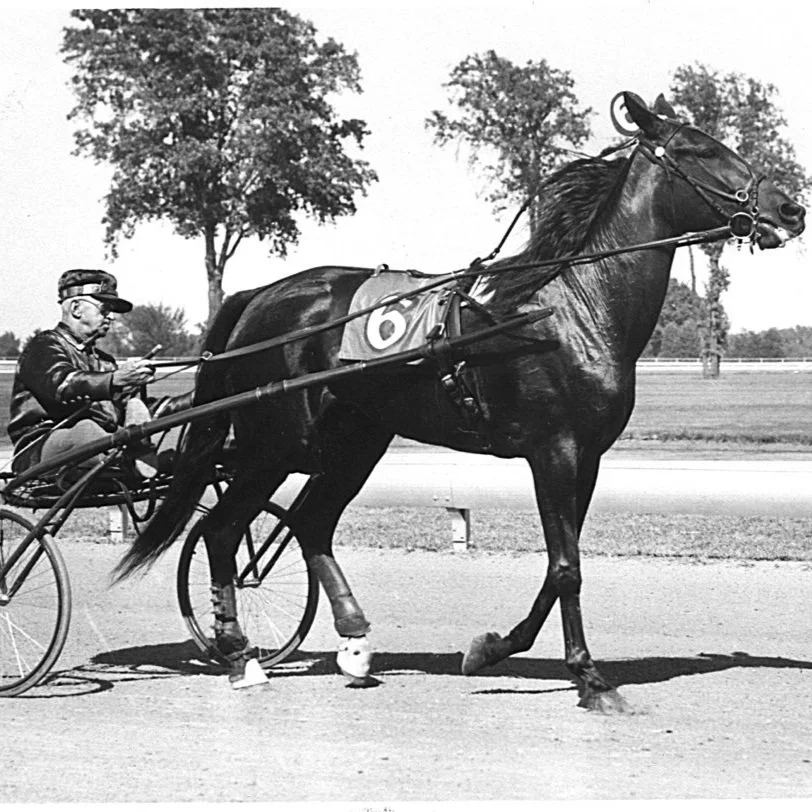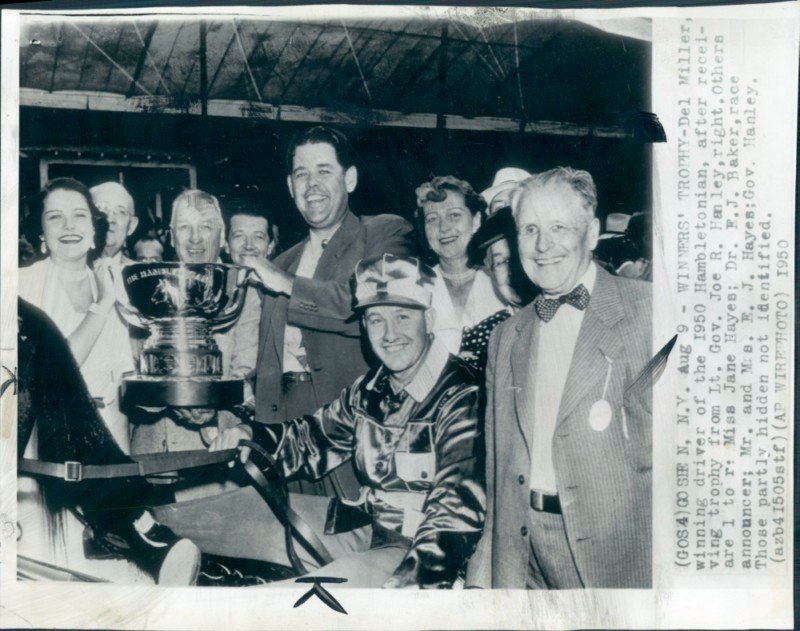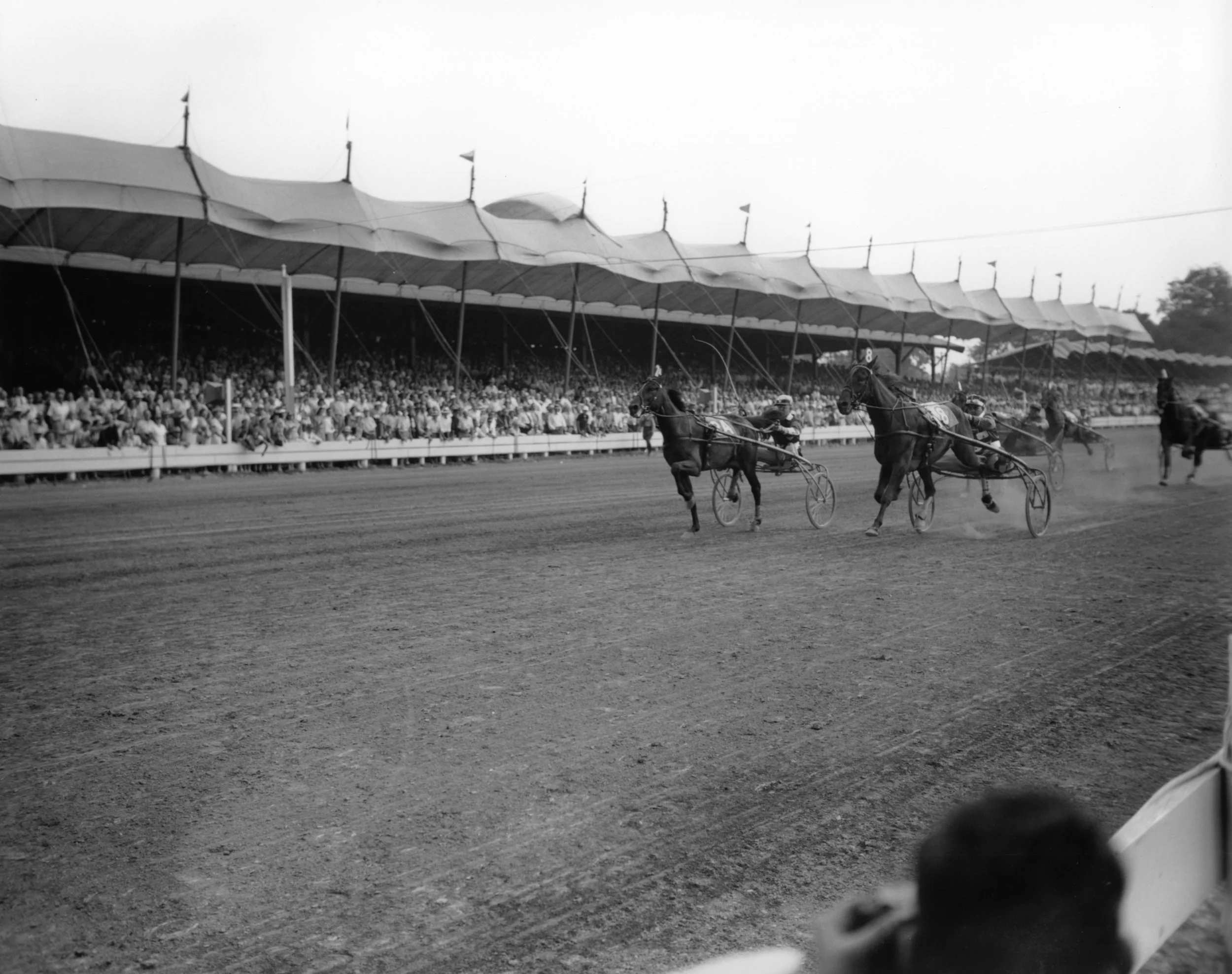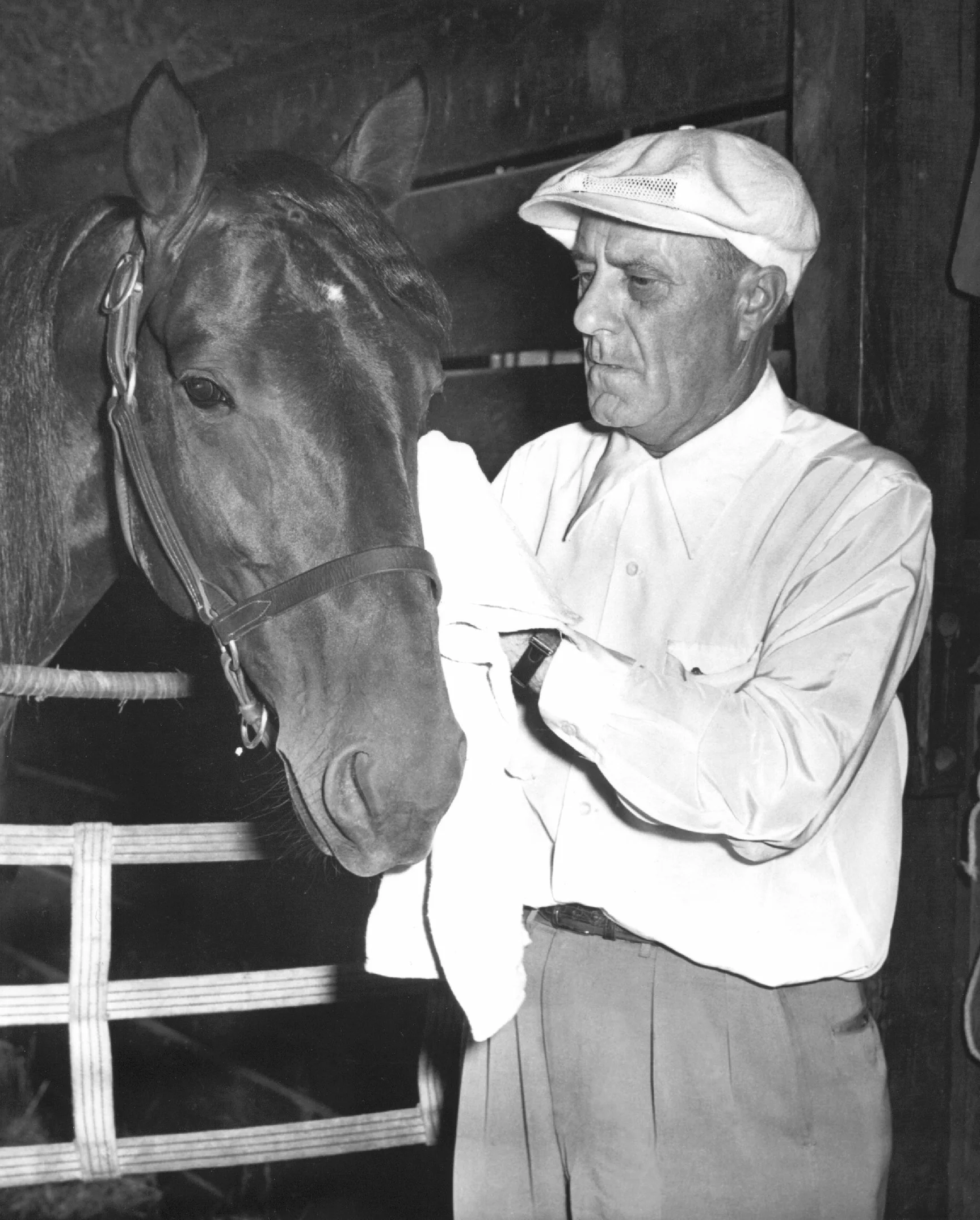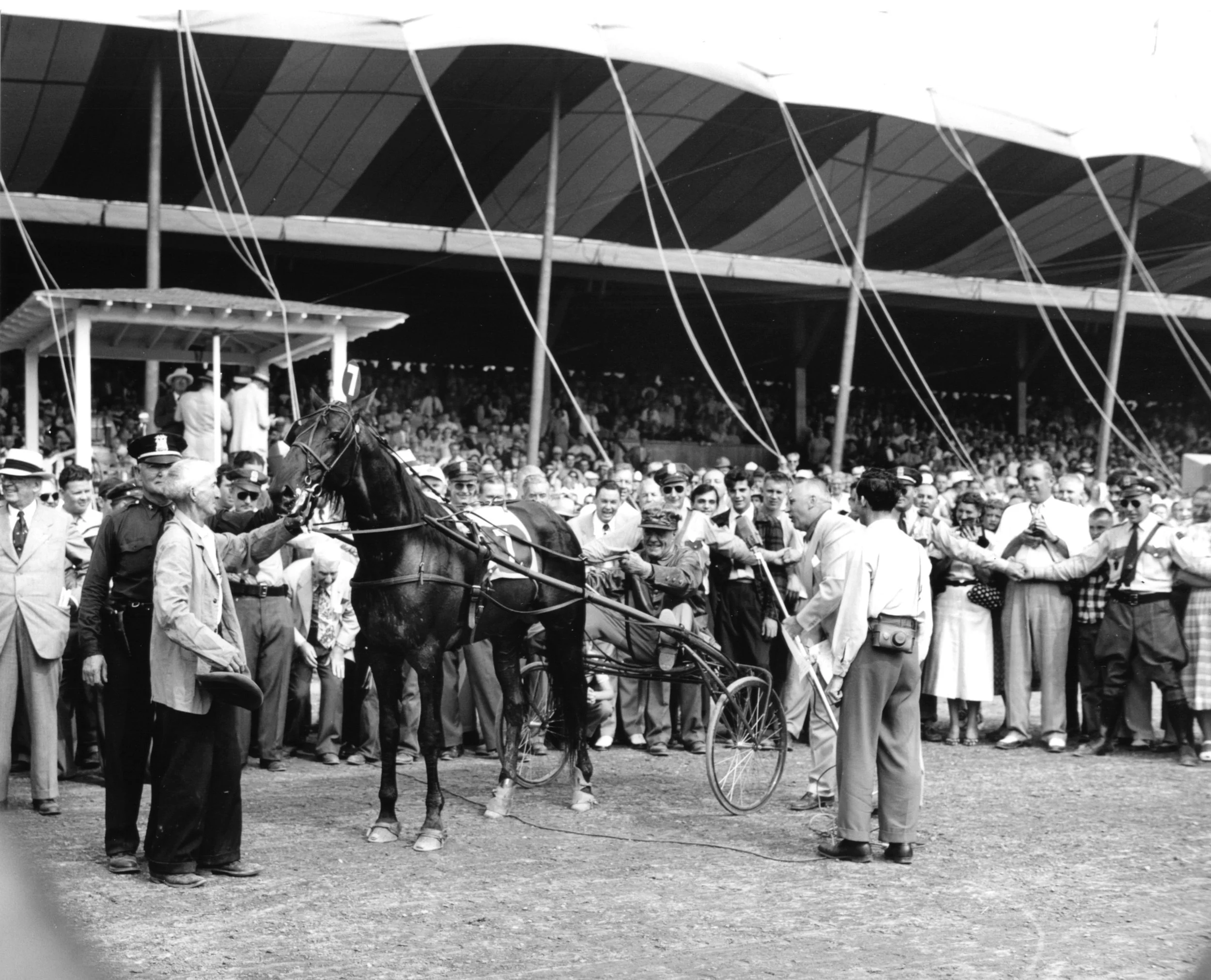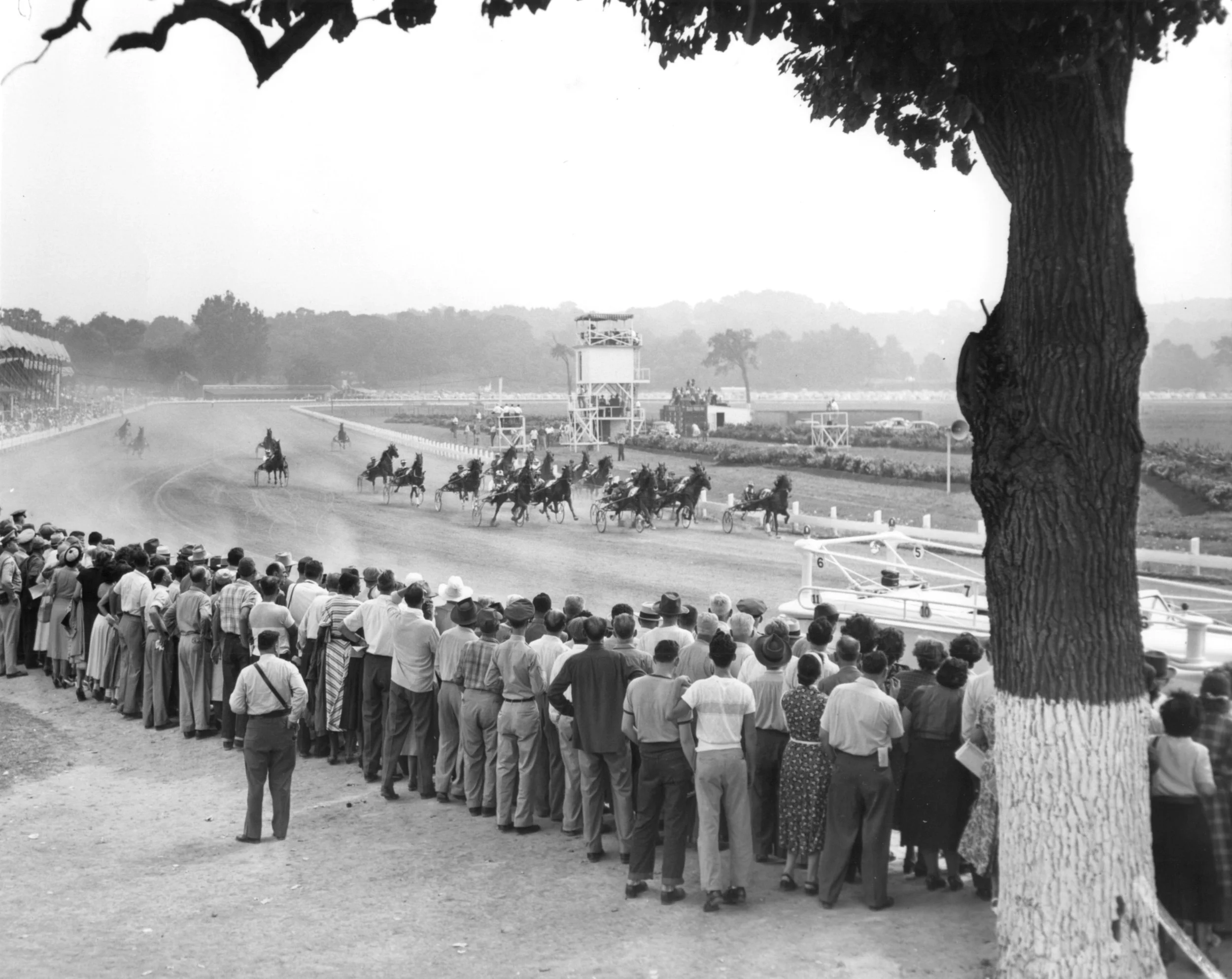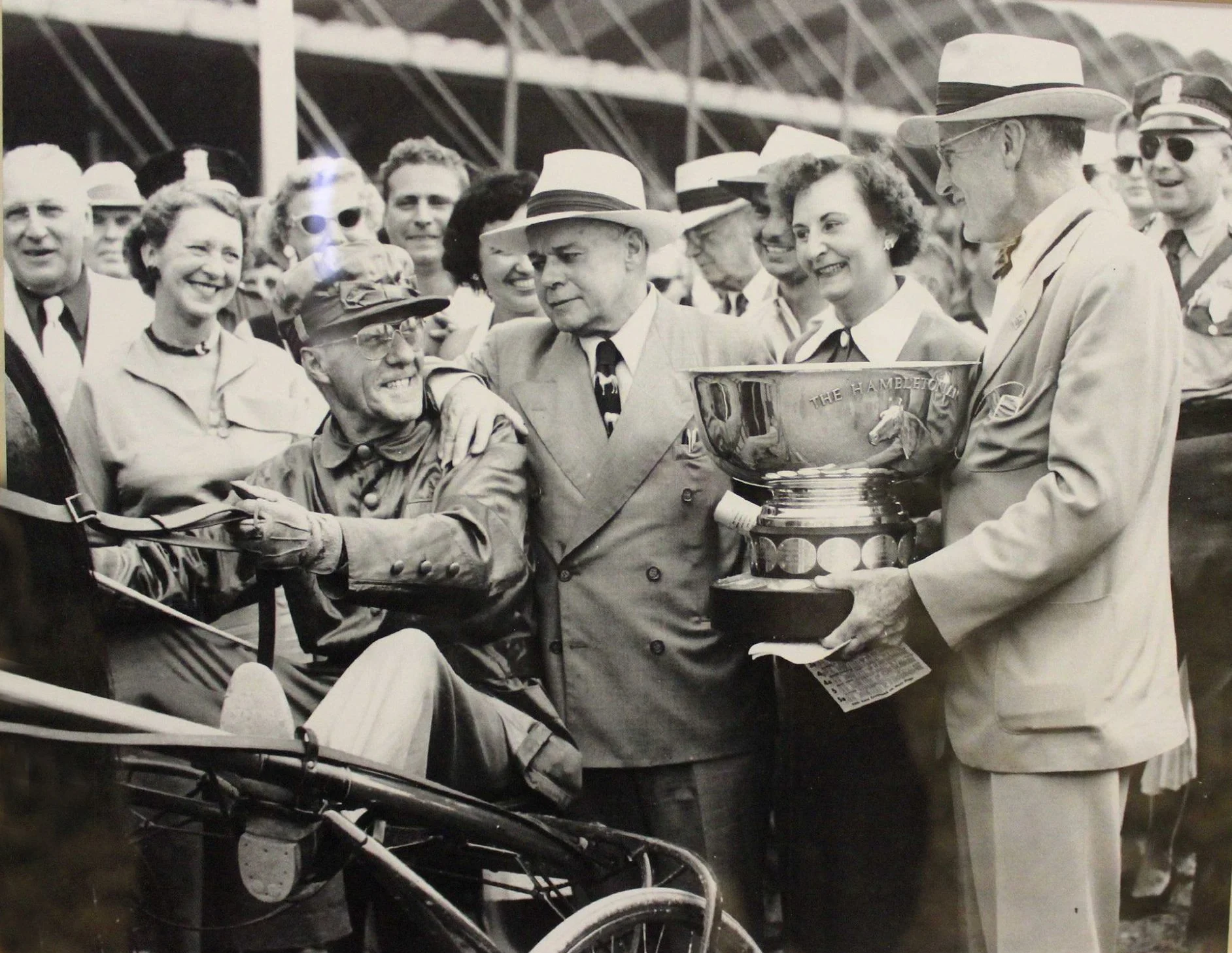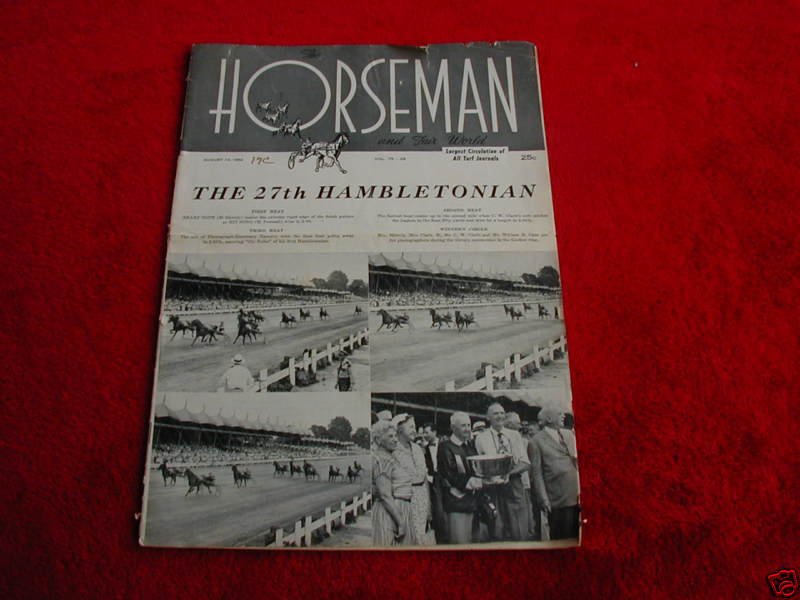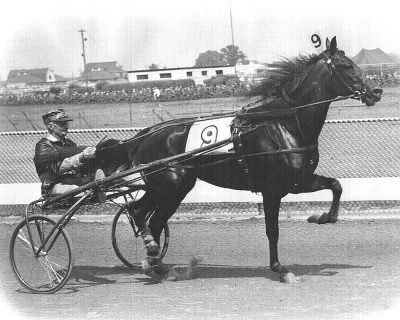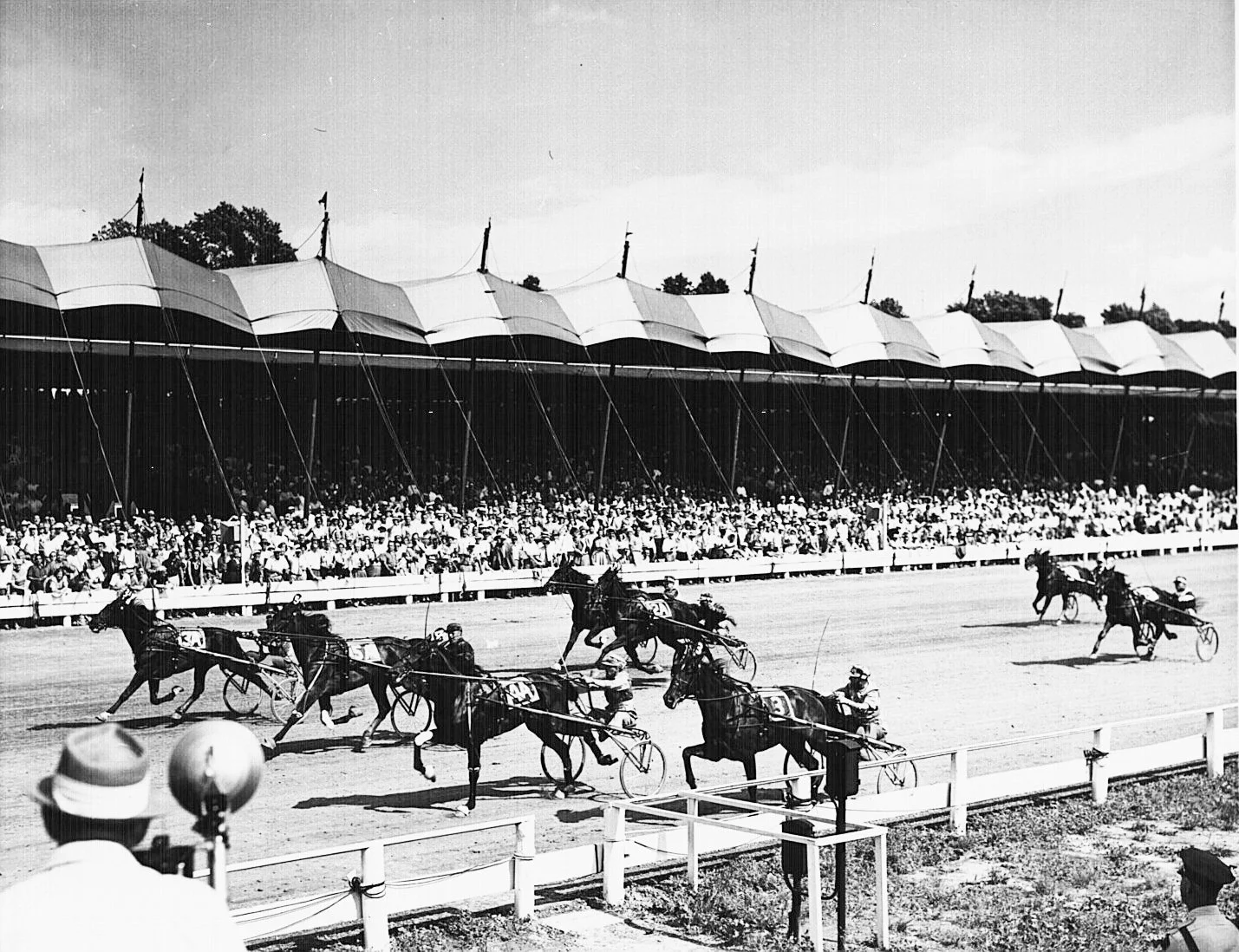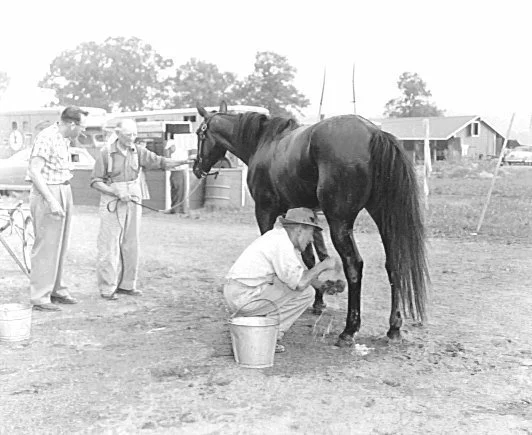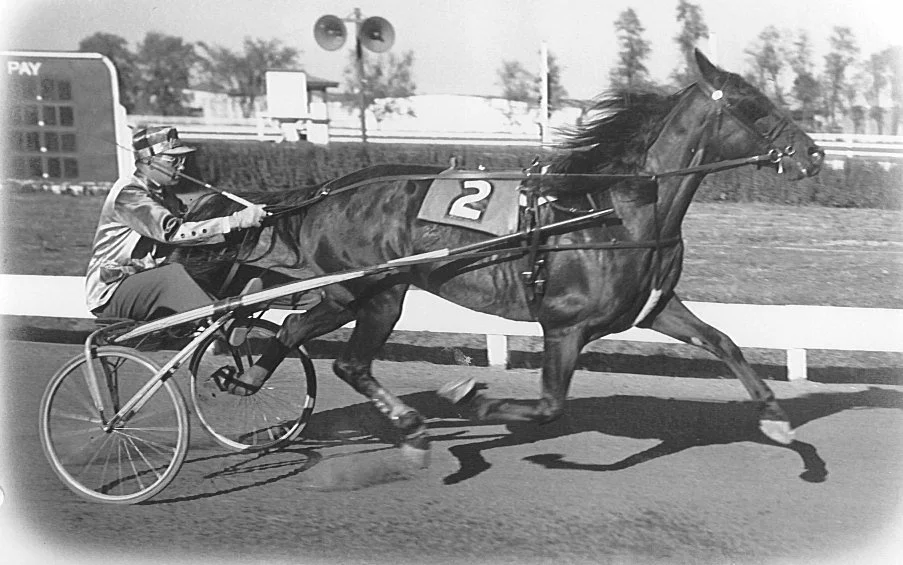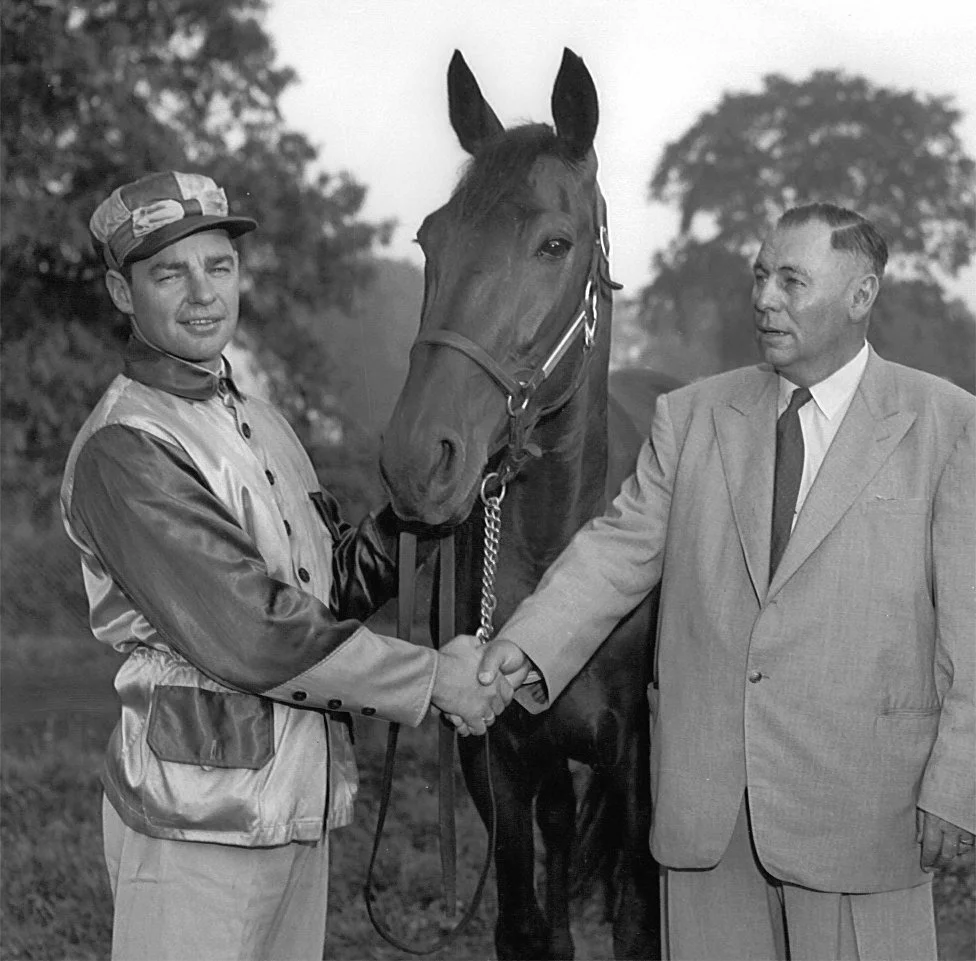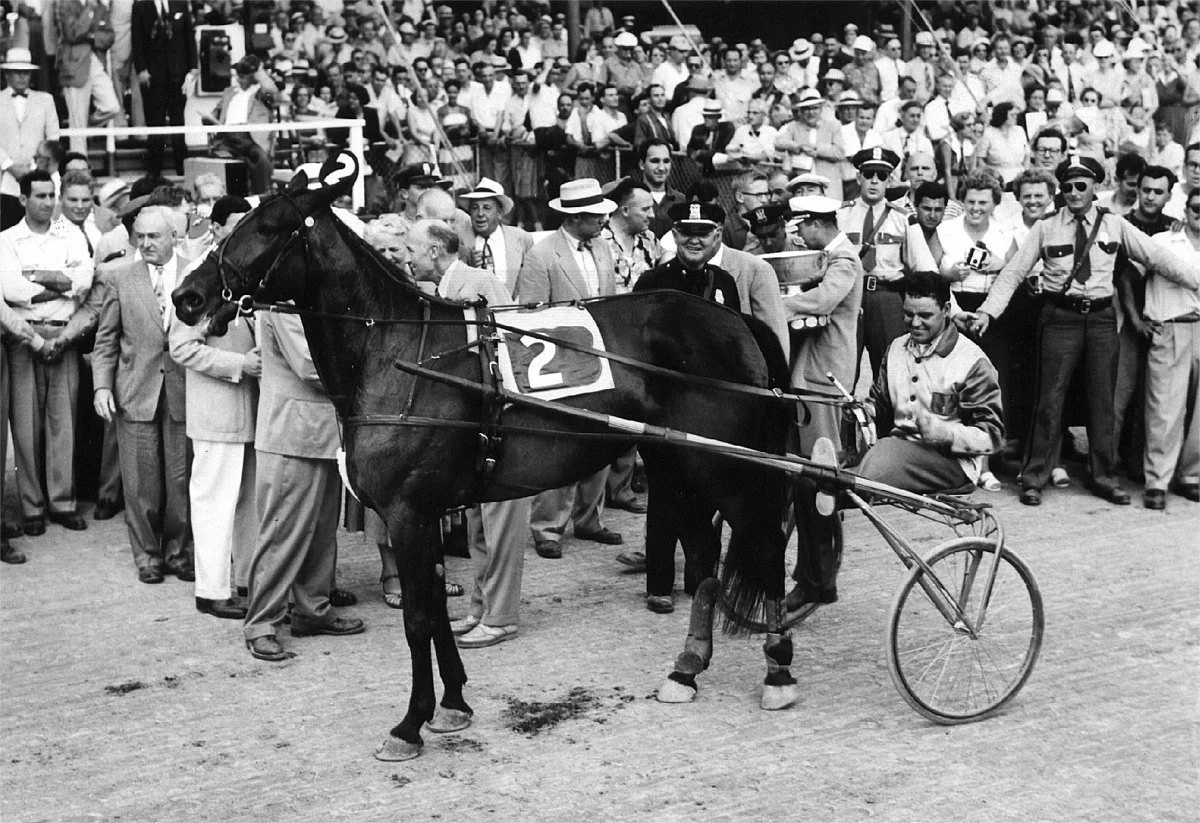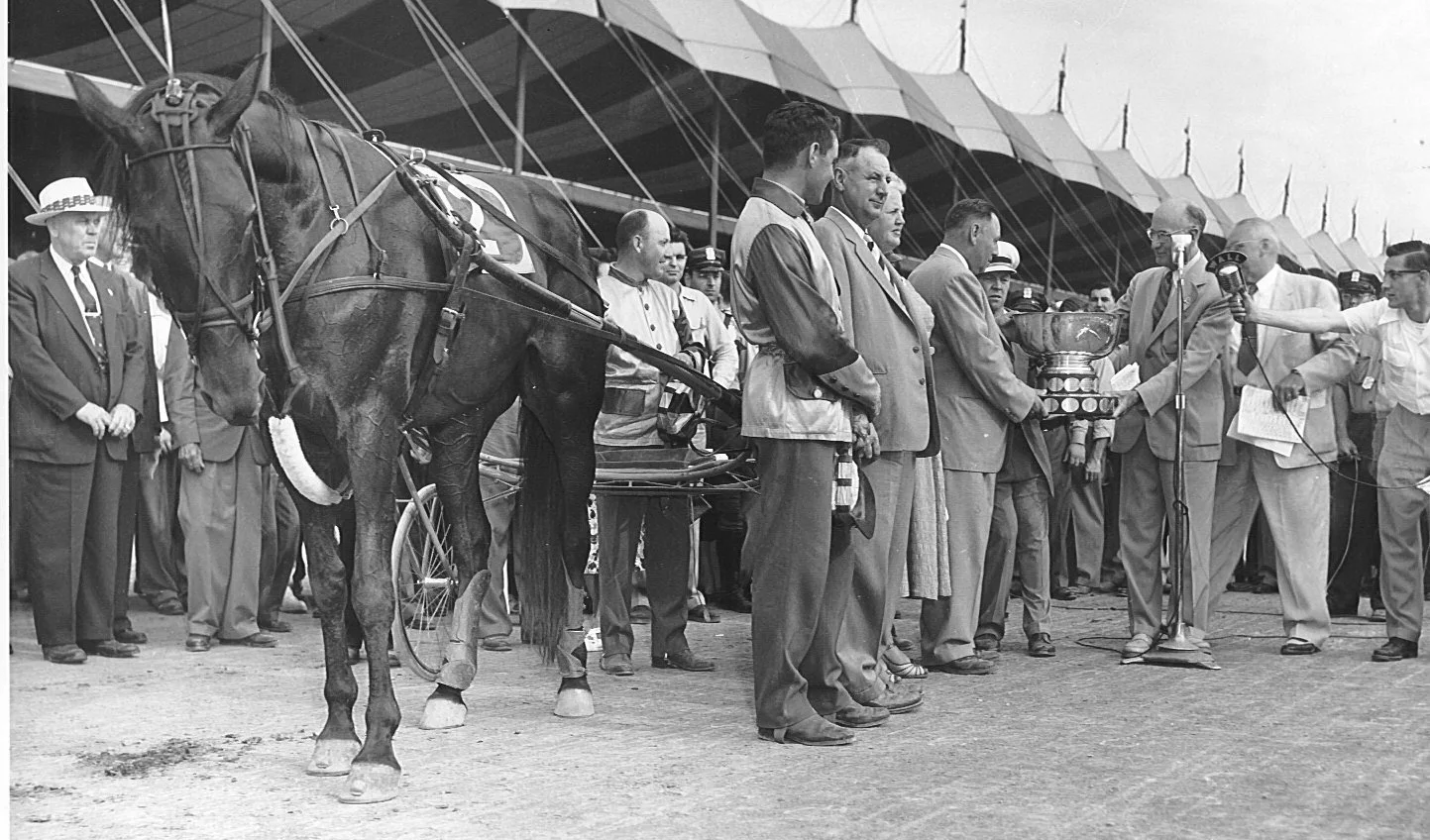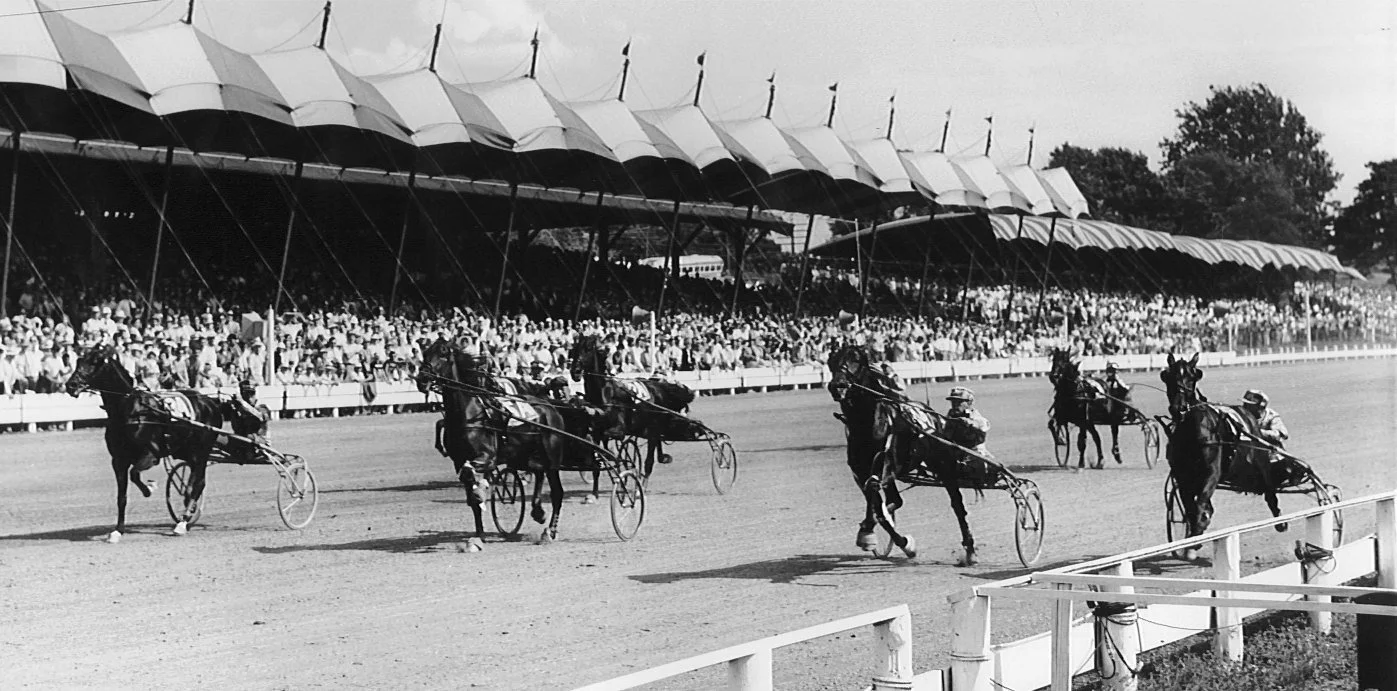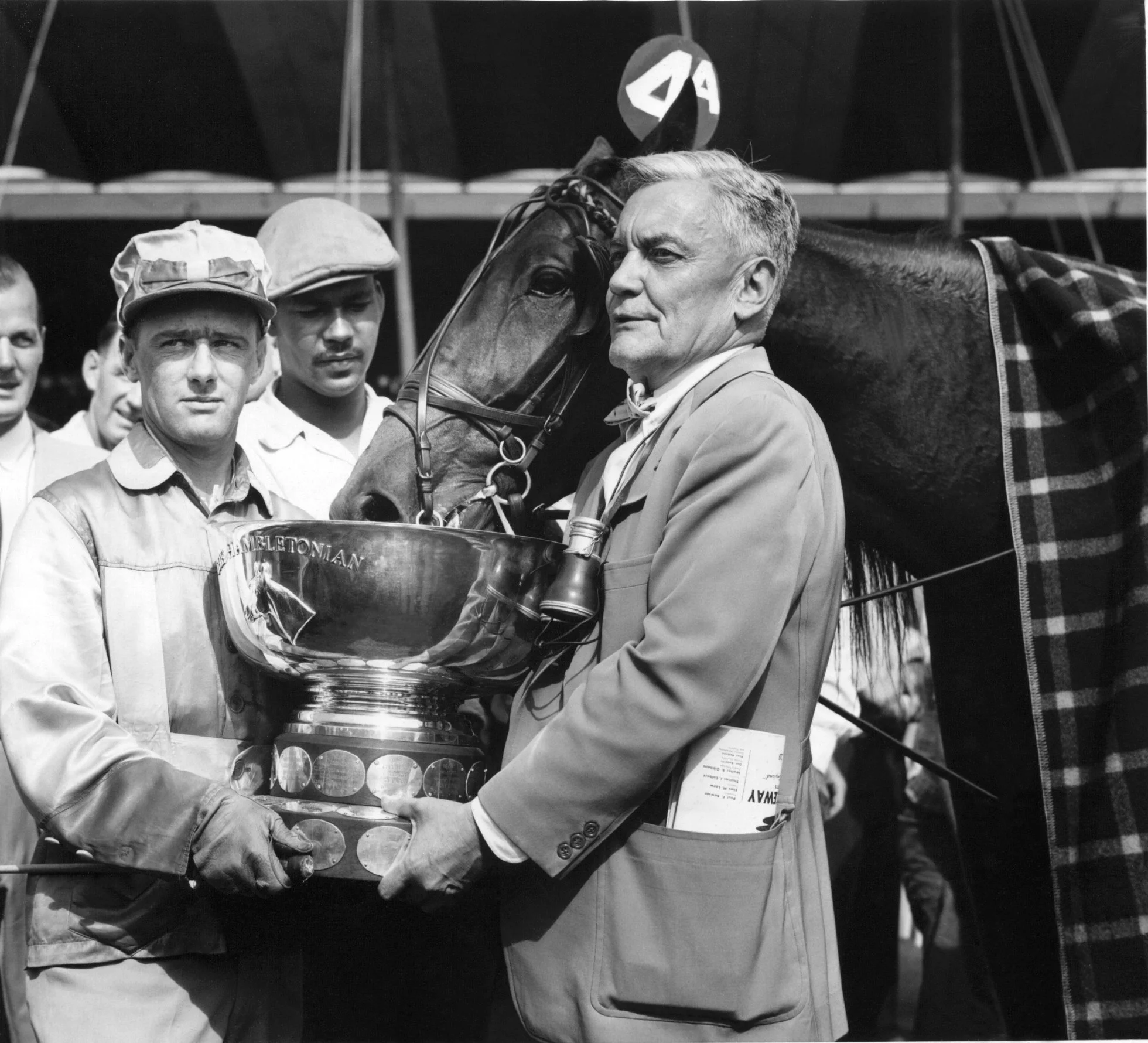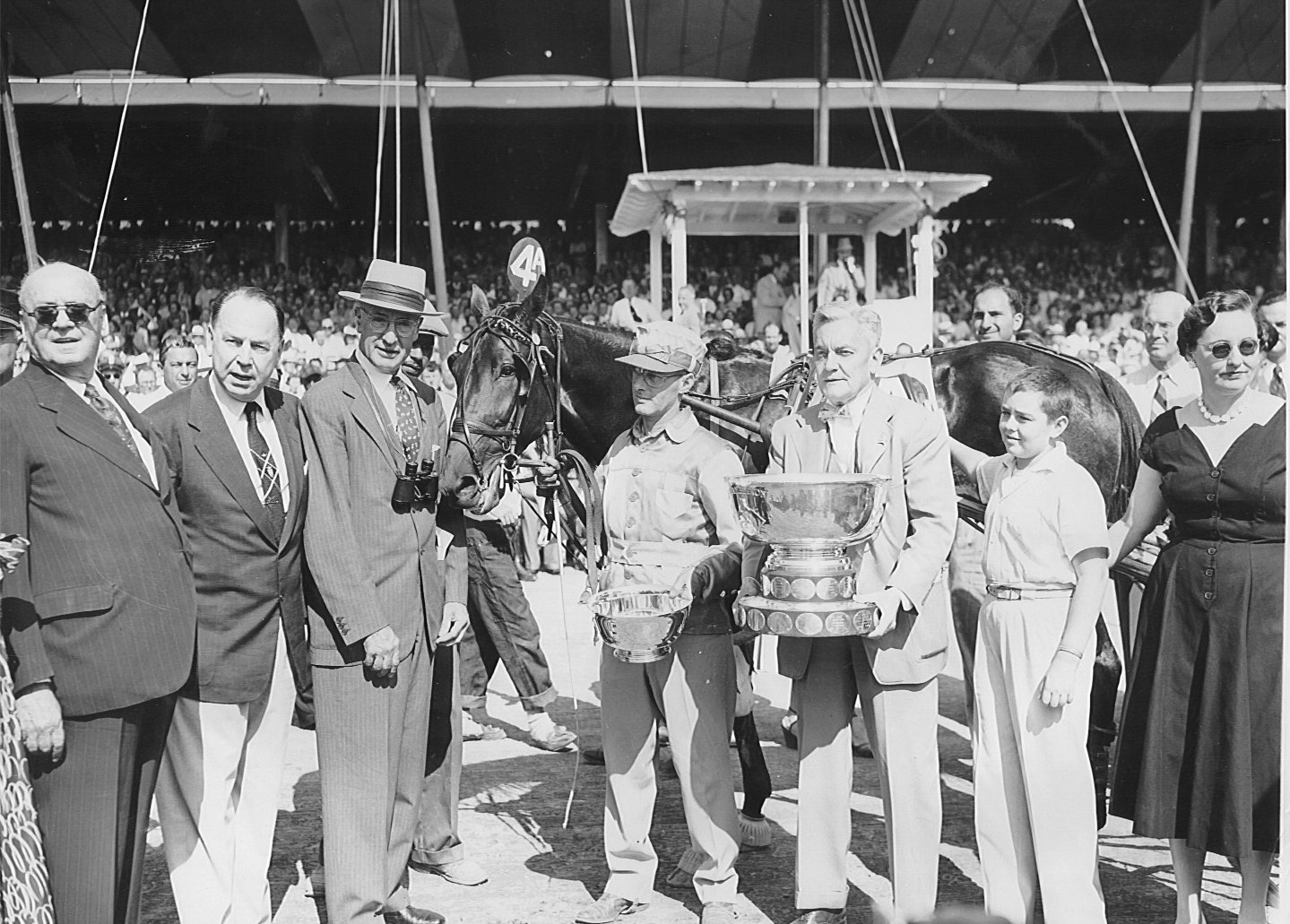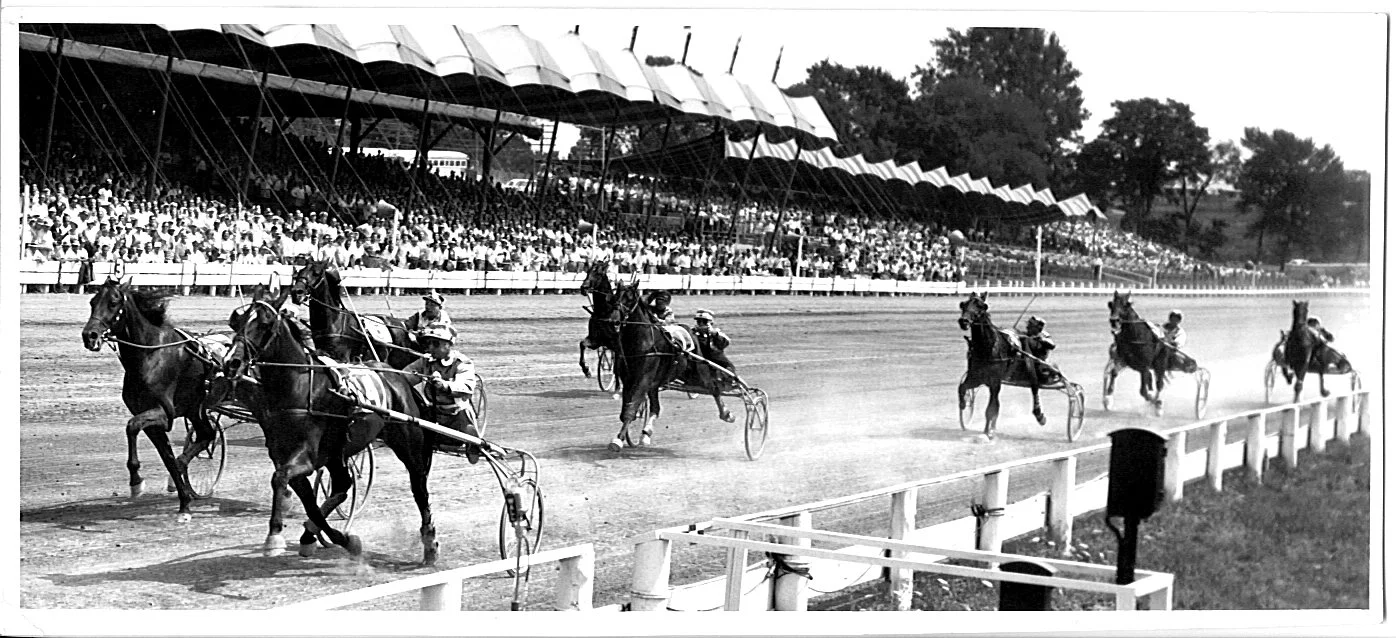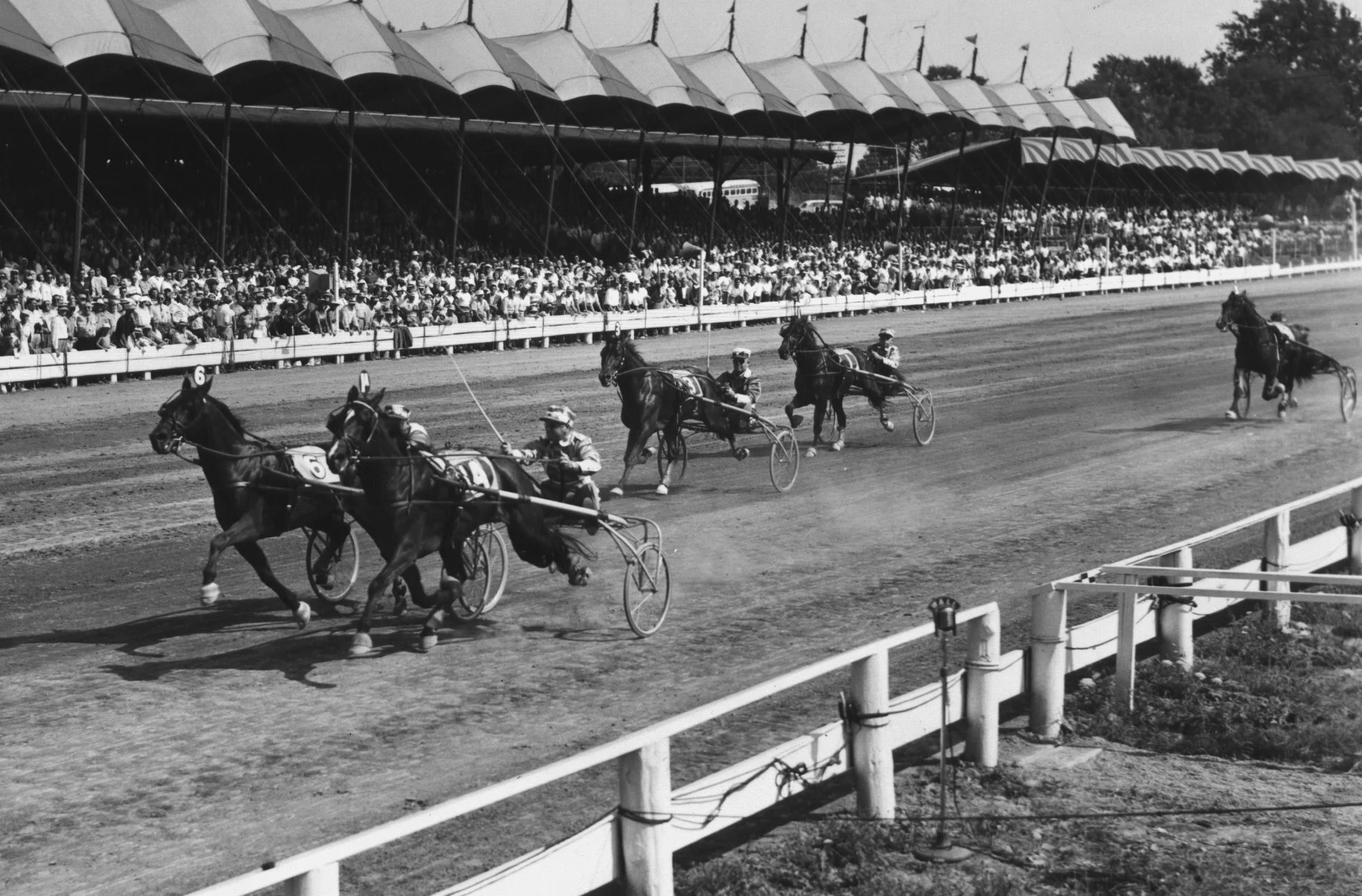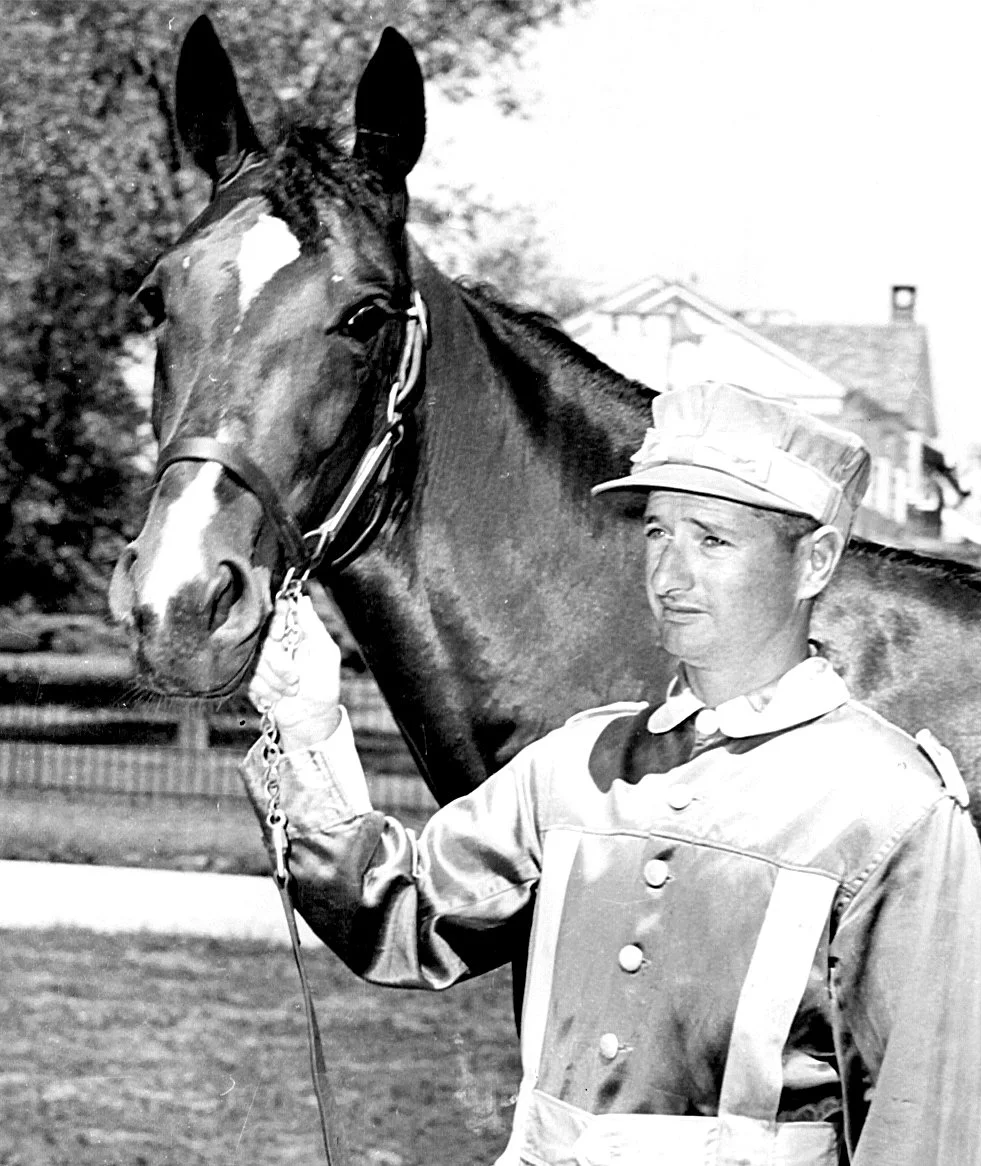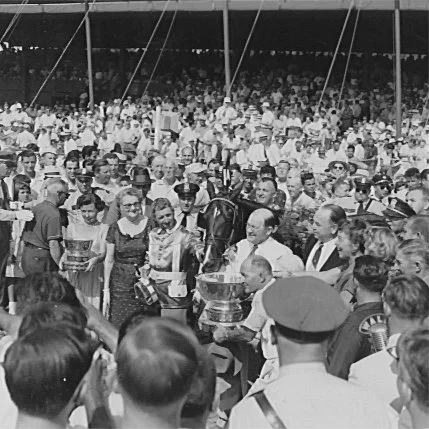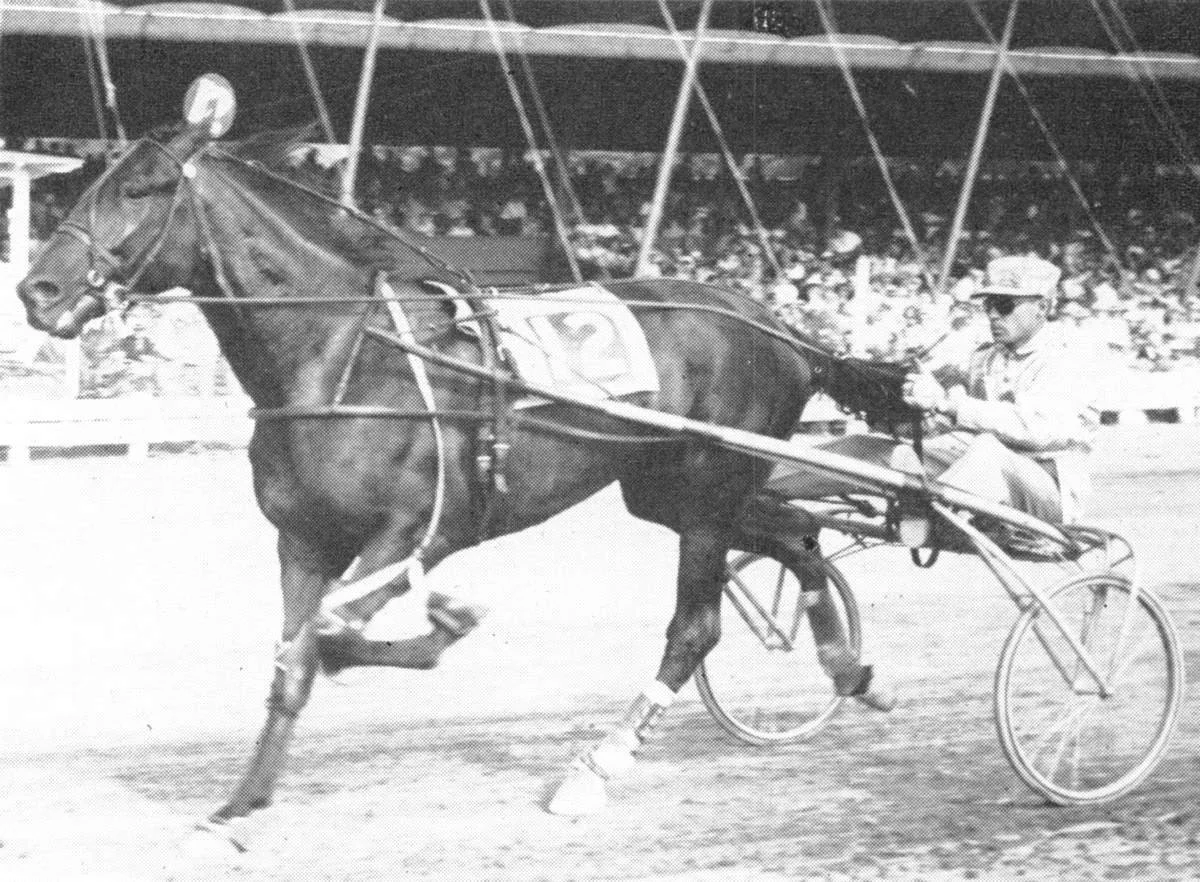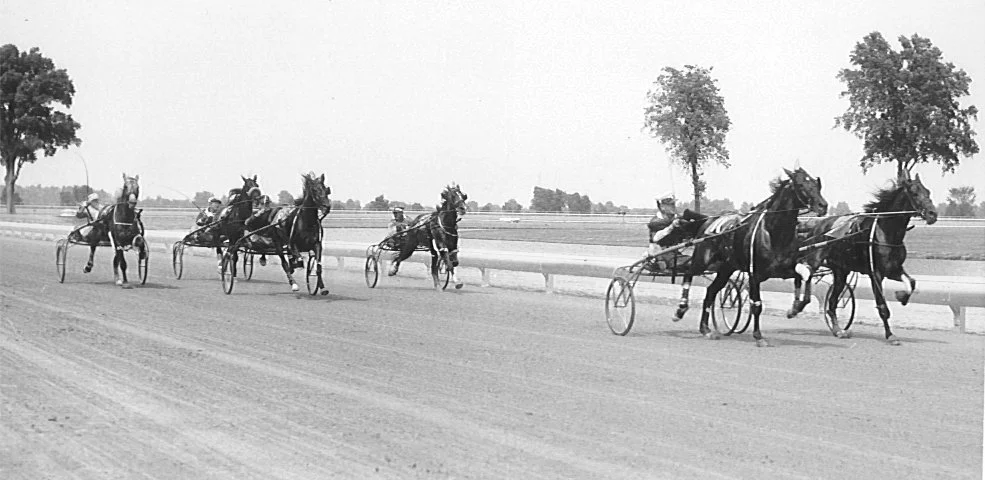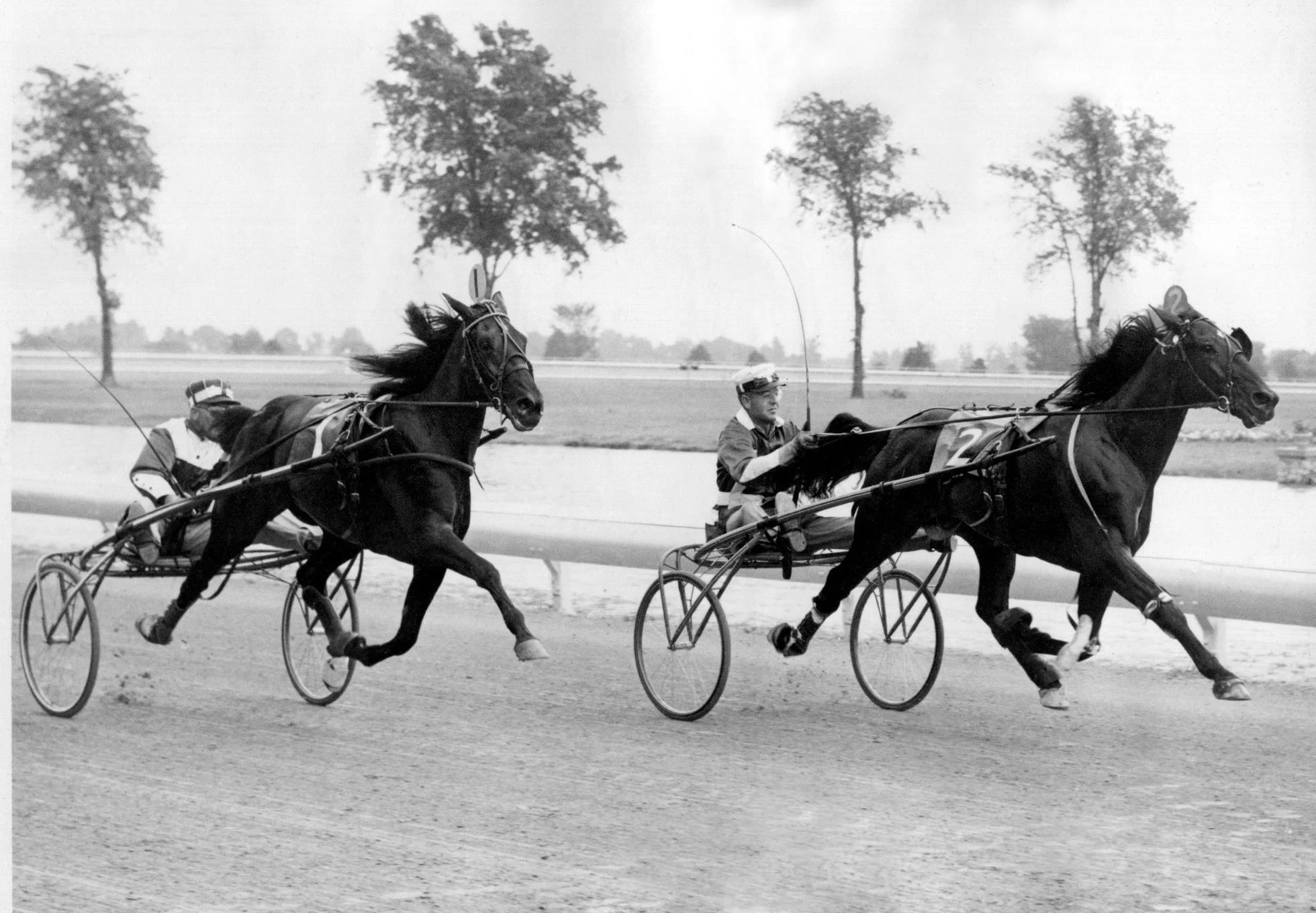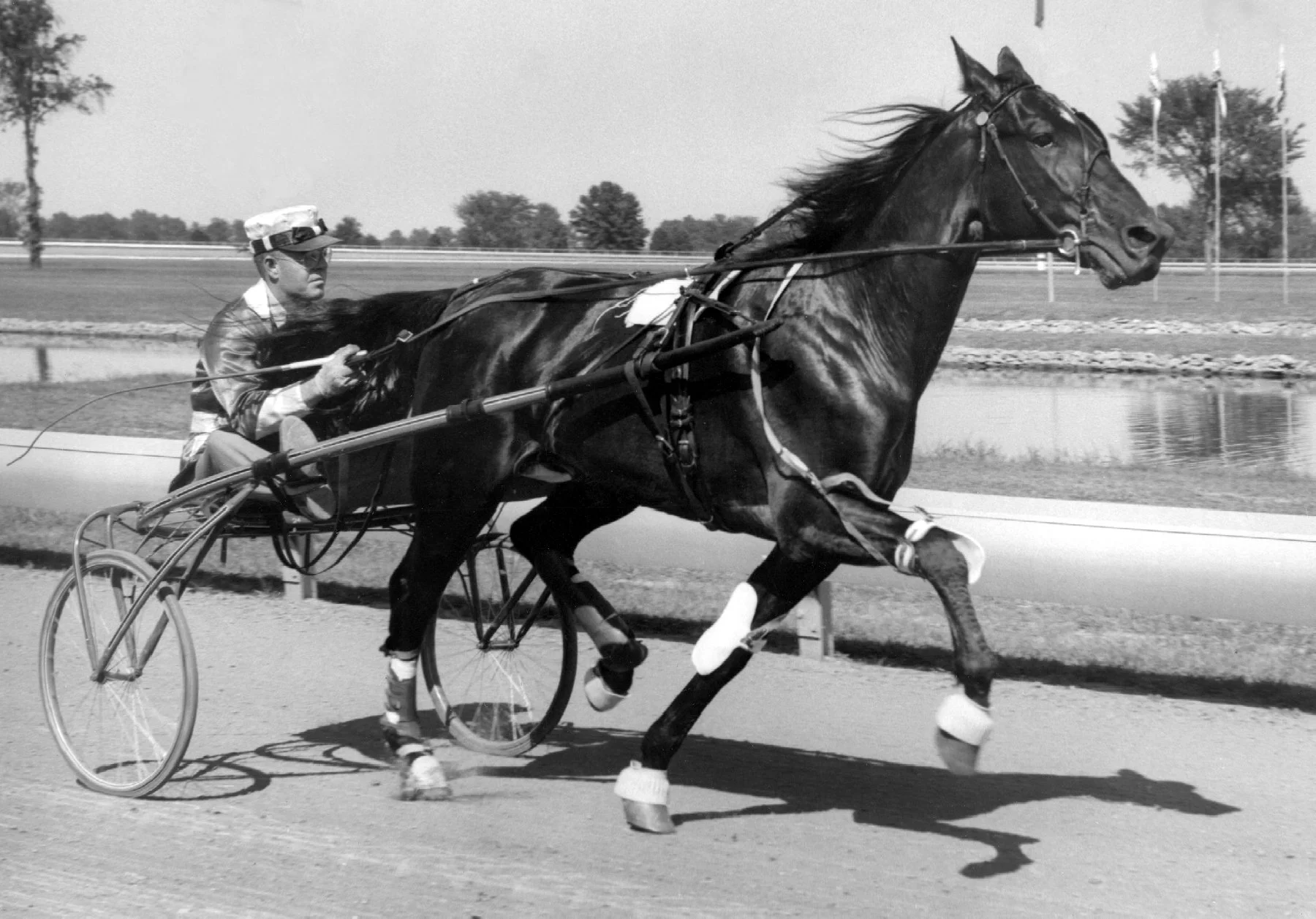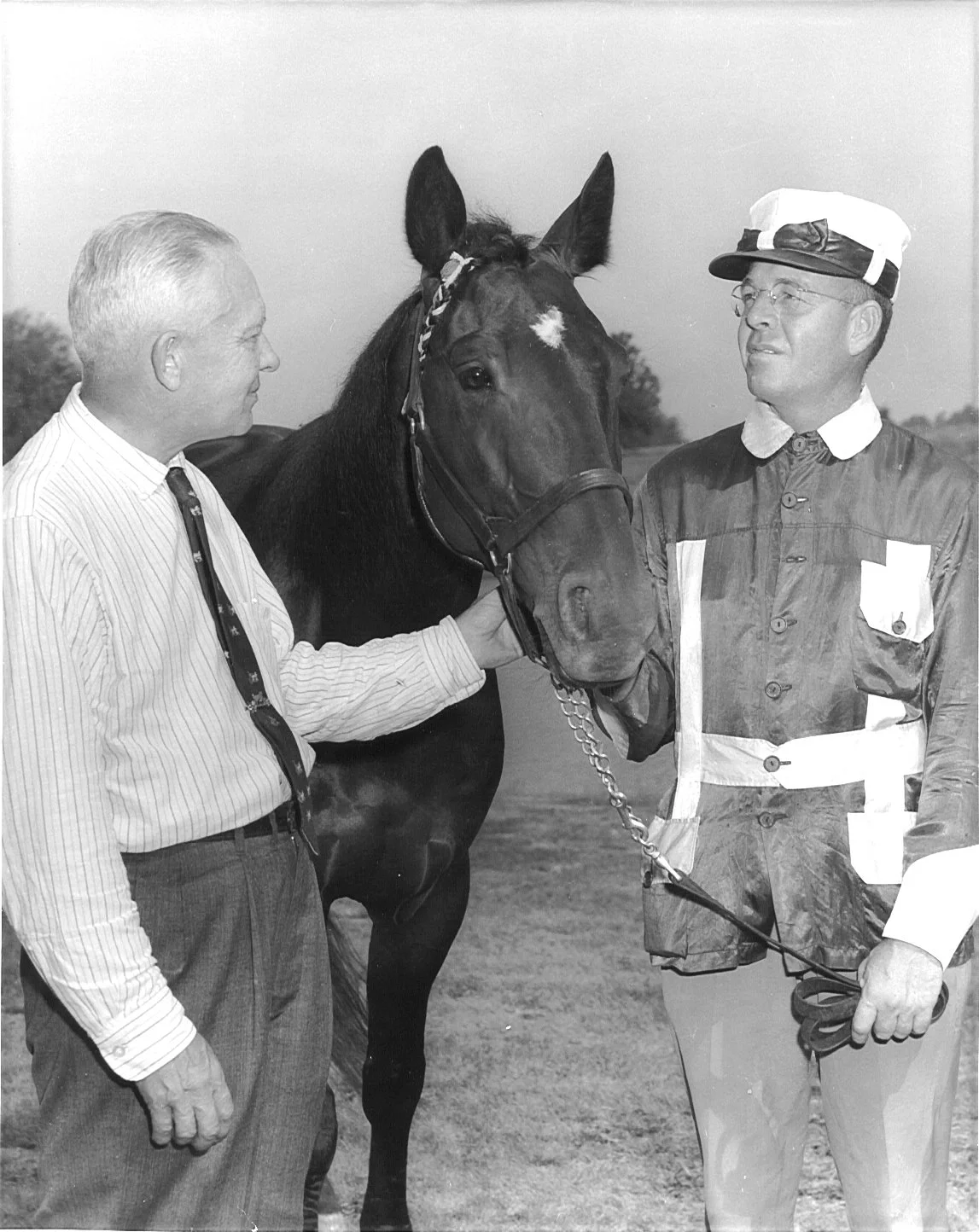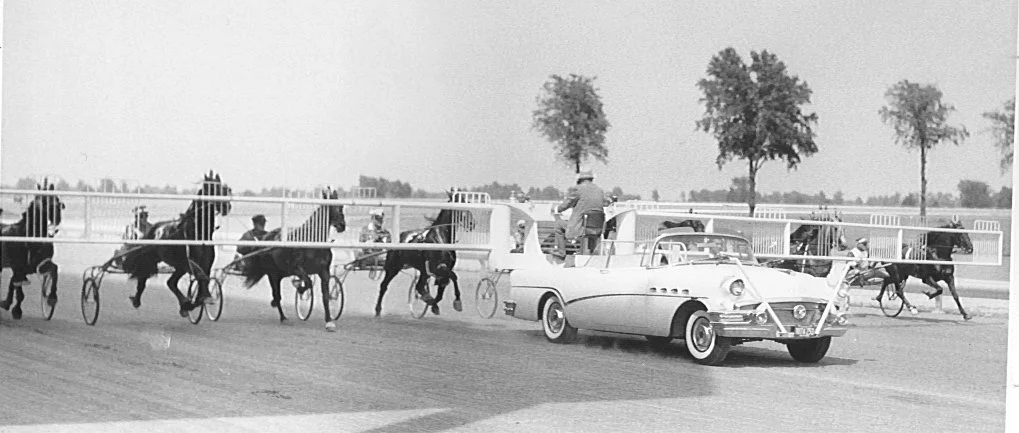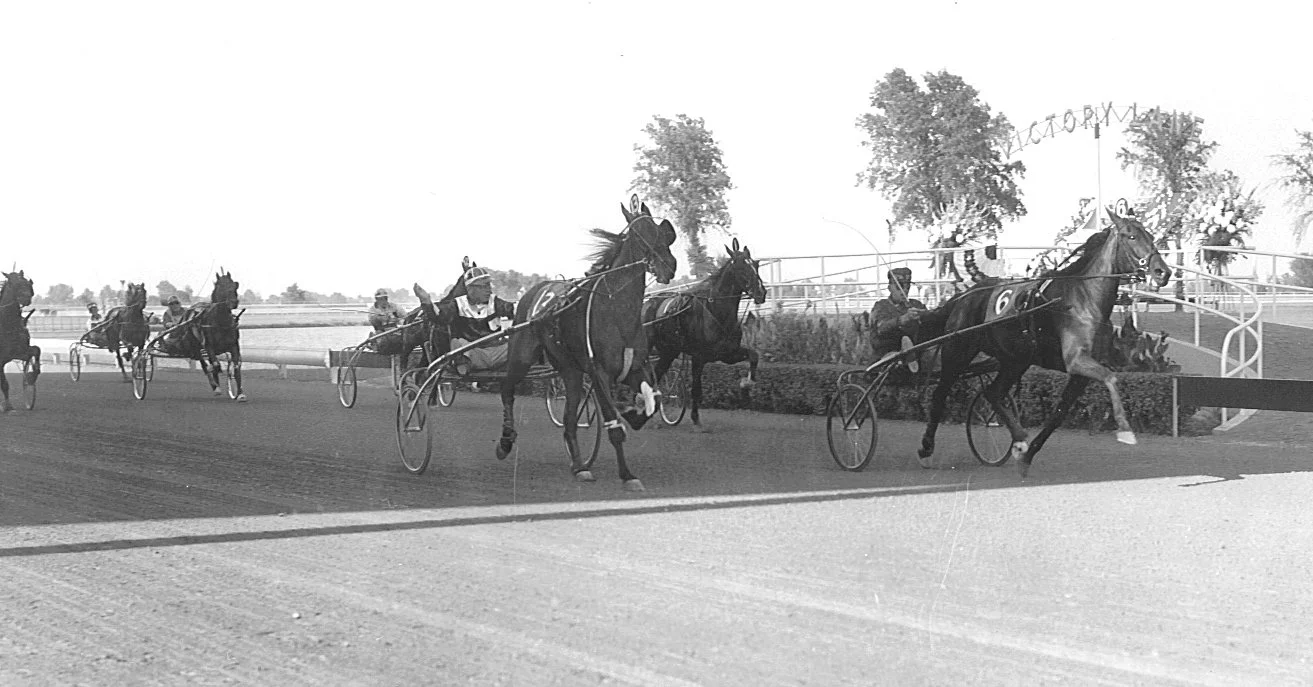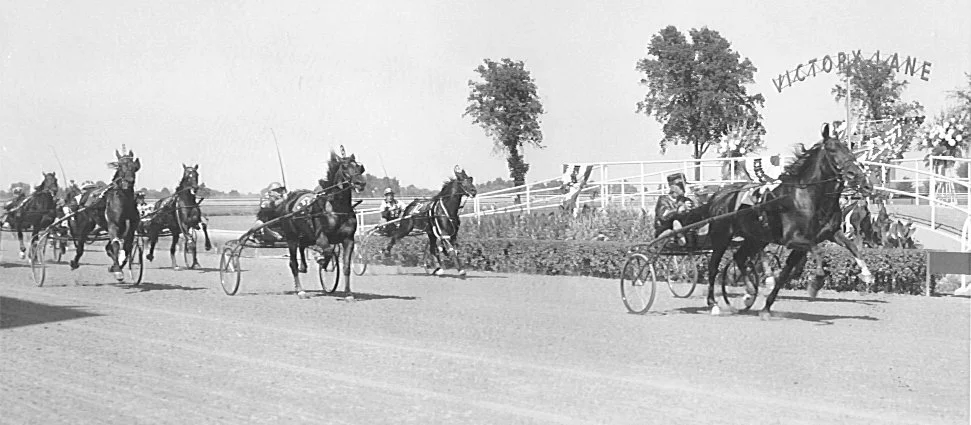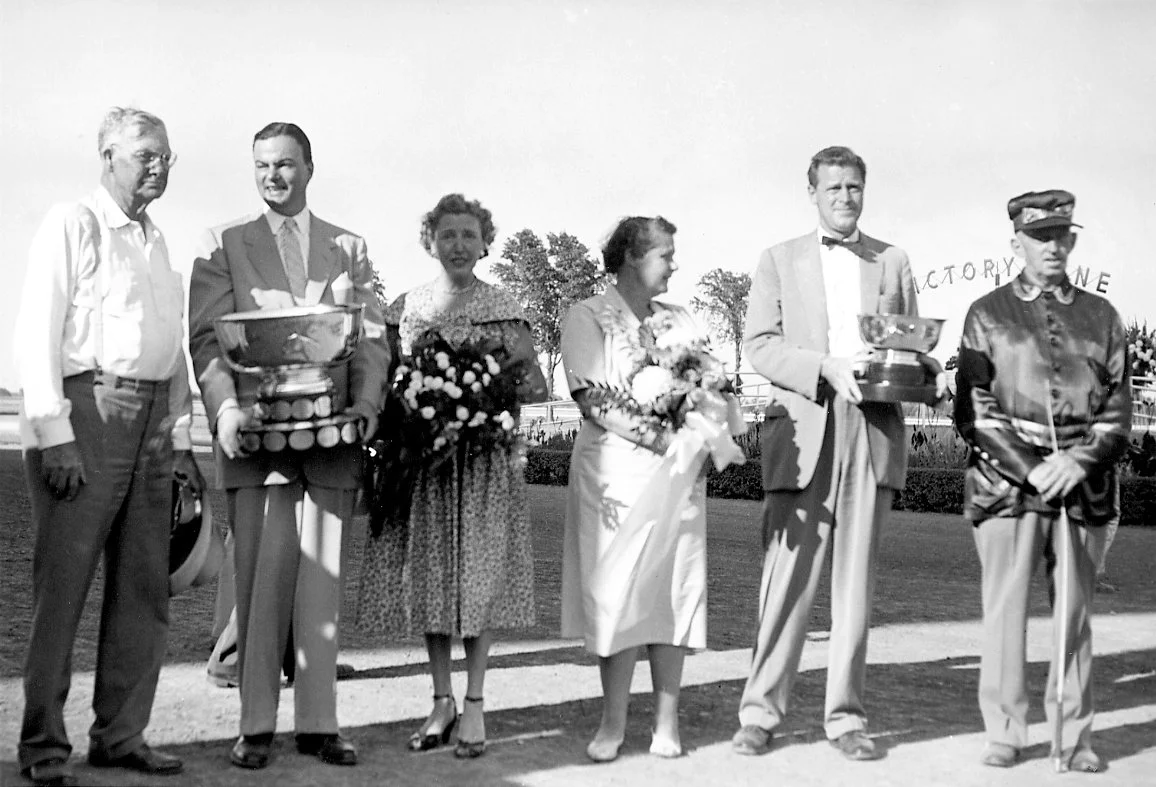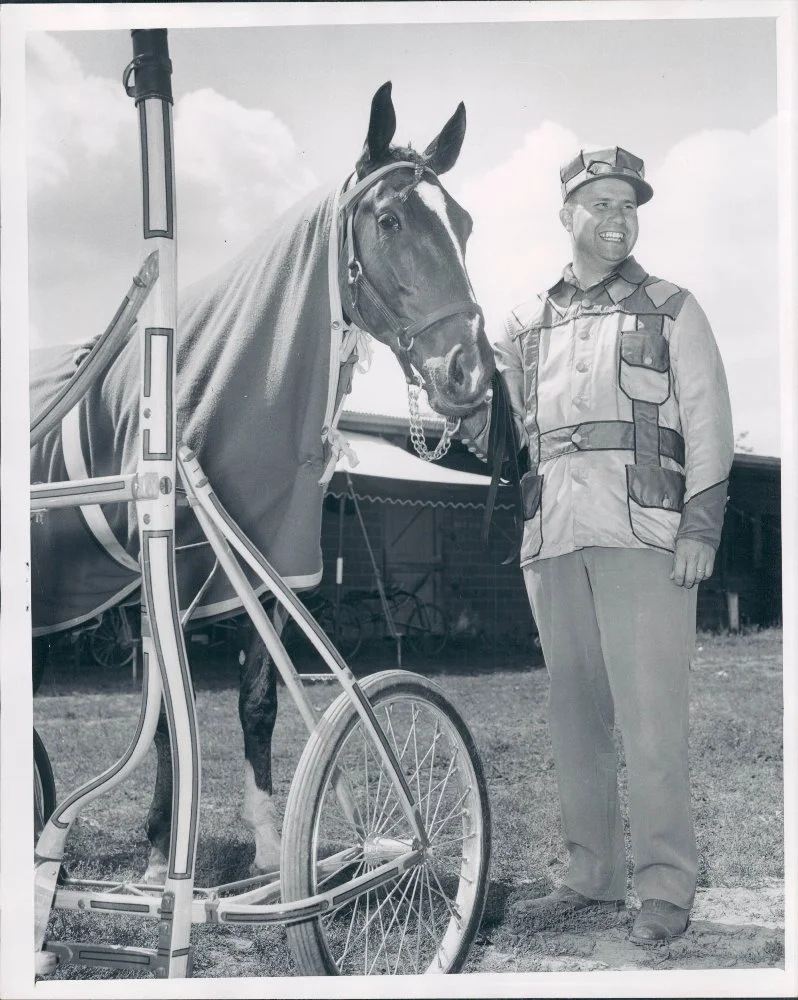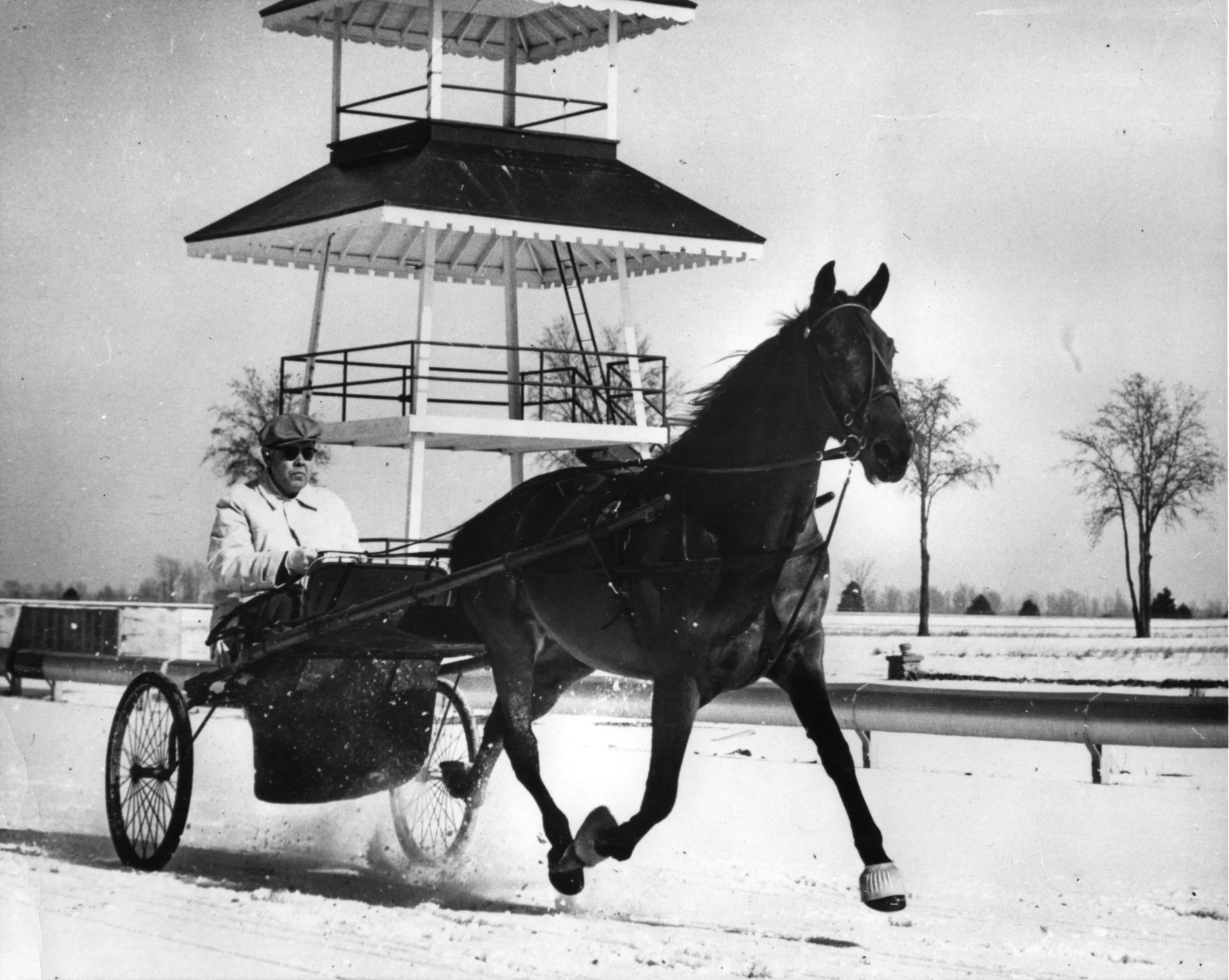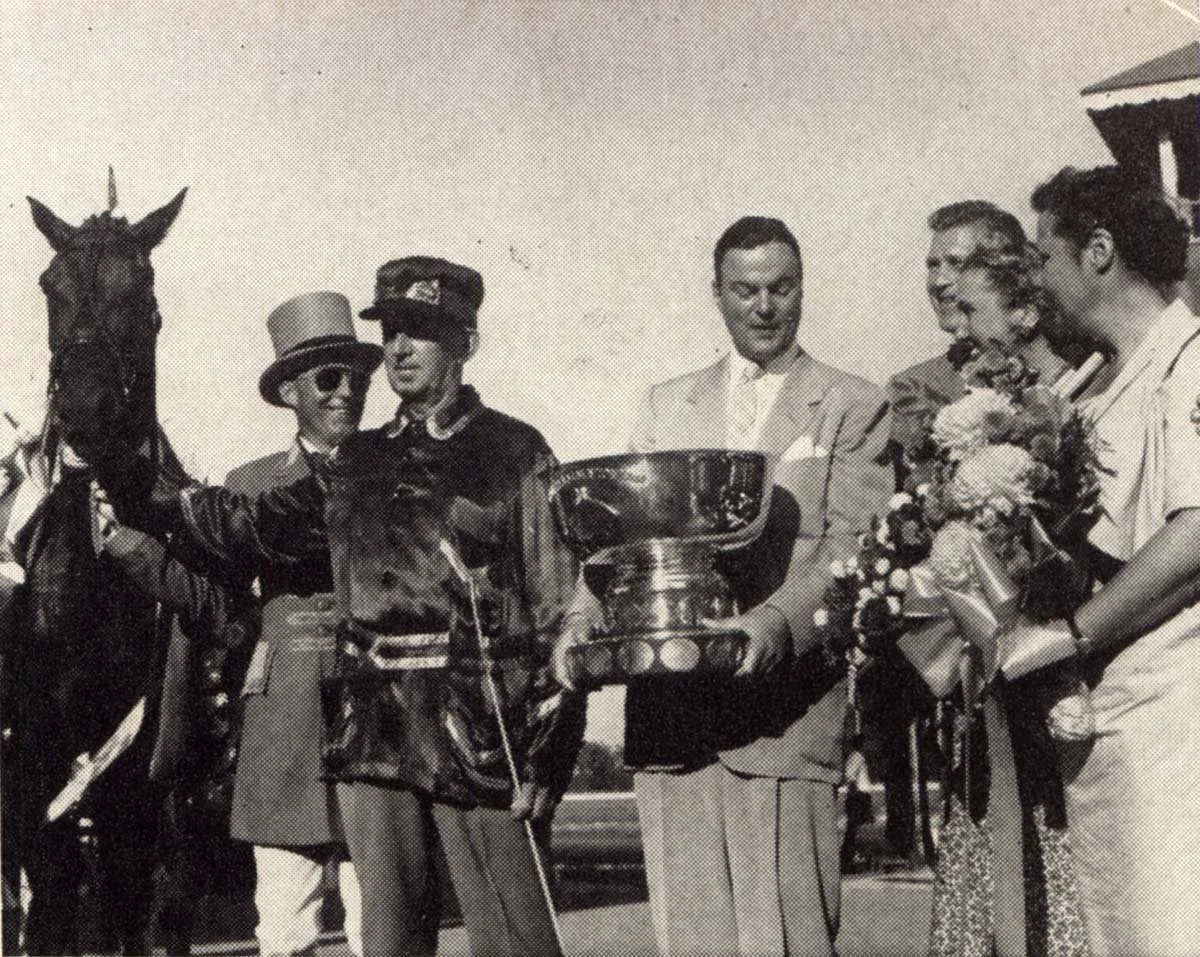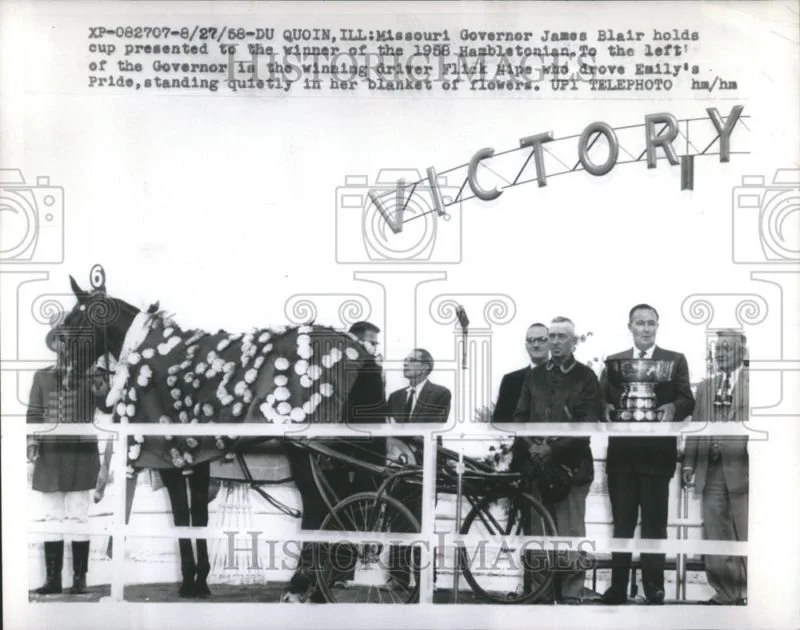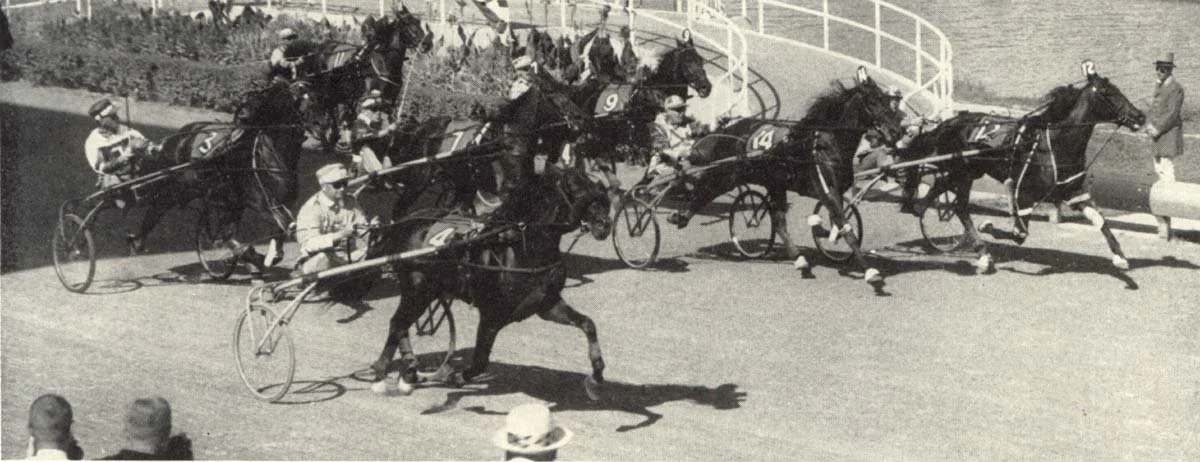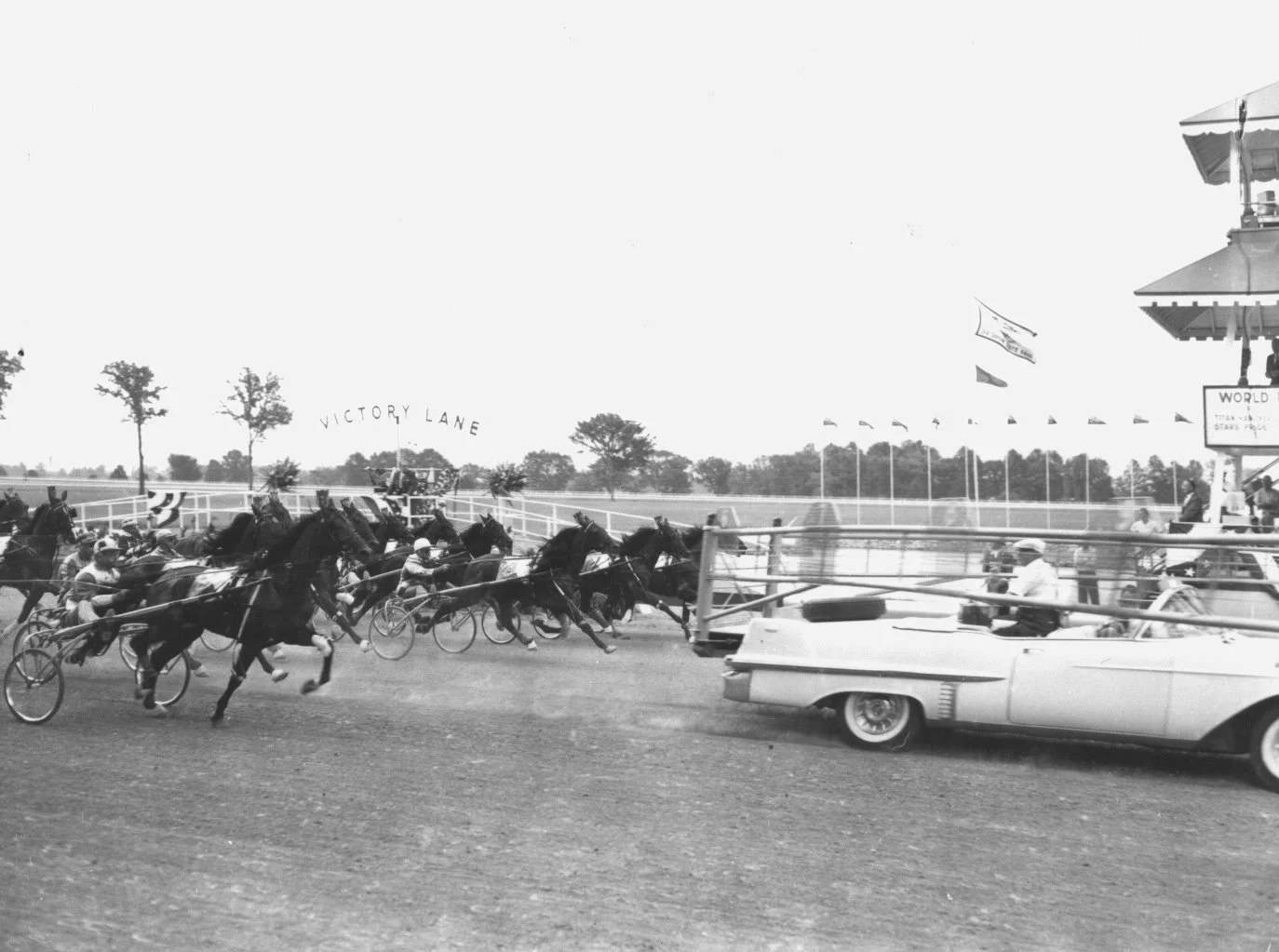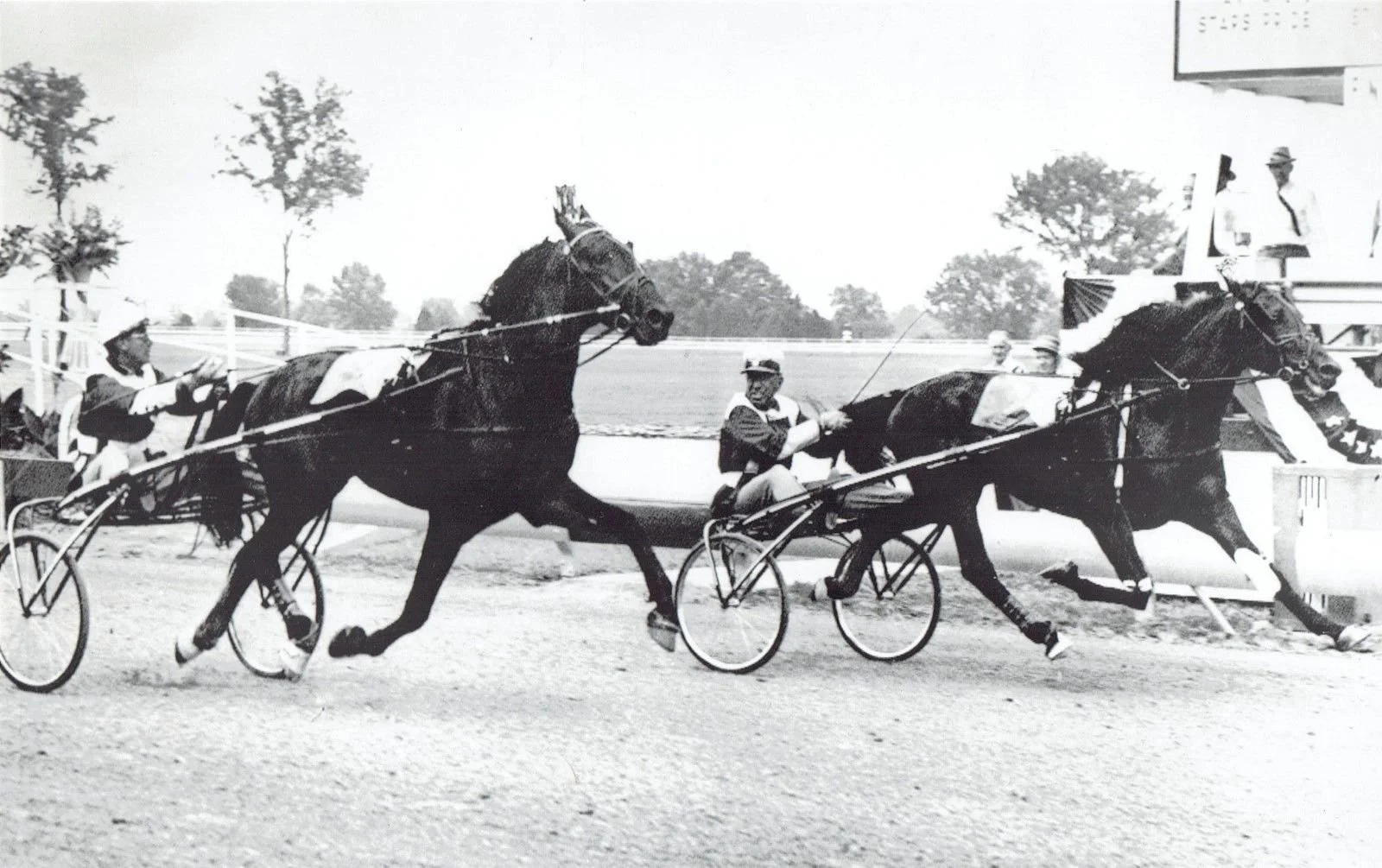Champions |1950-1959
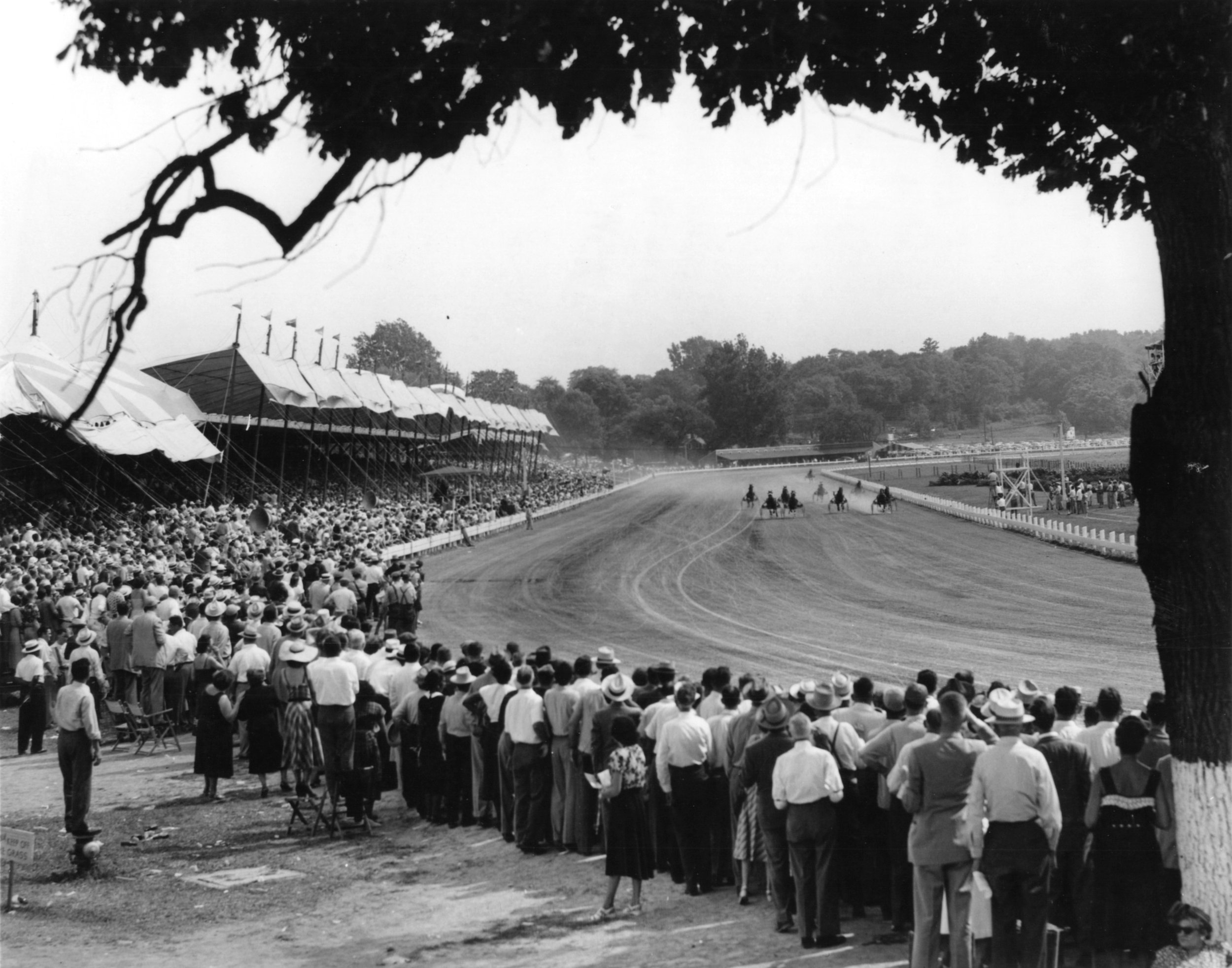
Born To Win
august 9, 1950
goshen, ny
good time park
Purse $73,704.94
Through his breeding, Lusty Song seemed destined to win the Hambletonian. His sire, Volomite, already had a trio of winners as well as the dam of a fourth. Peter Volo, his grandsire, had the same record. On his maternal side, his dam was by Scotland, the leading sire of Hambletonian winners, with four, including then stakes record holder, Hoot Mon. His granddam, Evensong, had produced the 1943 winner, Volo Song. Lusty Song was chosen by Dr. Hugh M. Parshall for the Hayes Fair Acres Stable of DuQuoin, IL, as a yearling for $7,600. At two, the colt had established himself as the fastest juvenile trotter in a race with his 2:02.1 victory in the Horseman Stake and topped his division in earnings with $47,799.29. His nemesis at three was Star’s Pride, who beat him at Historic and Saratoga. But he reached the winner’s circle in the $10,000 Volomite at Westbury, and was kept on edge with a 2:02 workout leading up to the Hambletonian, where Delvin Miller took over the driving assignment. Lusty Song won the first heat by a length over Star’s Pride, but the final was extremely tight. Miller moved to the top early with Star’s Pride shuffled back. The Worthy Boy colt challenged from the head of the stretch home and inside the sixteenth pole, the pair was stride for stride. Lusty Song rallied to win by a short head.
Delvin Miller won his first of three Hambletonians with a horse he catch drove. Ironically, it was his only victory as a driver. Lusty Song had been developed by Miller’s friend, Doc Parshall, at two and when Parshall was taken ill, the colt was turned over to Foy Funderburk the first part of his three-year-old year. Lusty Song started 32 times as a two-year-old for Parshall with 19 victories. It remains a record for the most two-year-old starts and wins ever for a Hambletonian winner. The average 2-year-old season for Hambletonian winners has been 16 starts with eight victories. Lusty Song was the leading money winning three-year-old to that point in time with $77,142; $40,537 earned in the Hambletonian. In 1985, Prakas set a single season money record for a trotter of $1,610,608. His winner’s share of the Hambletonian purse that year was $636,000. 37-year-old Delvin Miller led the sport with a record $311,809 in purse monies and a .501 U.D.R.S. In addition to these and the Grand Circuit titles, he was second to John Simpson in the dash championship (111 to 108). He also won the premier events in each two and three-year-old division for both trotters and pacers: Little Brown Jug (Dudley Hanover), the Horseman Stake (Mighty Fine) and the Fox Stake (Solicitor). The Hayes family, who in addition to Lusty Song also owned Dudley Hanover and Mighty Fine, would eventually host the Hambletonian in DuQuoin from 1957 to 1980. Finishing second (by a short head) and third in the final heat was the entry of Star’s Pride (2-2) and Florican (5-3), trained by Harry Pownall and both owned by E. Roland Harriman of Arden Homestead Stable. Star’s Pride was co-owned by Lawrence Sheppard.
Media
Champions |1950-1959

On Wisconsin
august 9, 1951
goshen, ny
good time park
Purse $93,358.65
A massive field of 20 went to post in two tiers in 1951 for the richest purse in harness racing history, $98,263.93. Driven by Guy Crippen, the roman-nosed Mainliner emerged the victor for Ralph H. Kroening of Milwaukee, Wisconsin. Kroening’s first Hambletonian starter, Lord Steward, finished third in 1950. Kroening, preoccupied by his engineering business, didn’t see the colt race until the Hambletonian. Sent off at 27-1, Mainliner rated early and brushed to the front past the three-quarters and won by two lengths over Spennib in 2:02.3. Crippen, who would die the following year at the age of 62, positioned the colt on the rail in the second heat, sitting third most of the way. Crippen moved Mainliner at the head of the lane, urging him to a length and a half advantage over Scotch Rhythm in 2:04.3.
A private $25,000 acquisition during the previous year’s Grand Circuit meeting at DuQuoin, Kroening purchased Mainliner from Sep Palin. Mr. Koening’s desire to win the Hambletonian was stimulated in part by reading Marguerite Henry’s Born To Trot. It was the second Hambletonian winner for Mainliner’s caretaker 71-year-old Mickey Jackman who also "rubbed" Titan Hanover (1945). A "mile-track trotter" Mainliner’s long odds (27-1) were due in part to his previous race, the Volomite Trot on Roosevelt Raceway’s half-mile oval. Mainliner made a break before the start and finished last. Probably the most memorable performance of the day was that of the filly Scotch Rhythm, who came from 19th to finish second in the final heat, beaten only a length by the "breezing" Mainliner.
Media
Champions |1950-1959
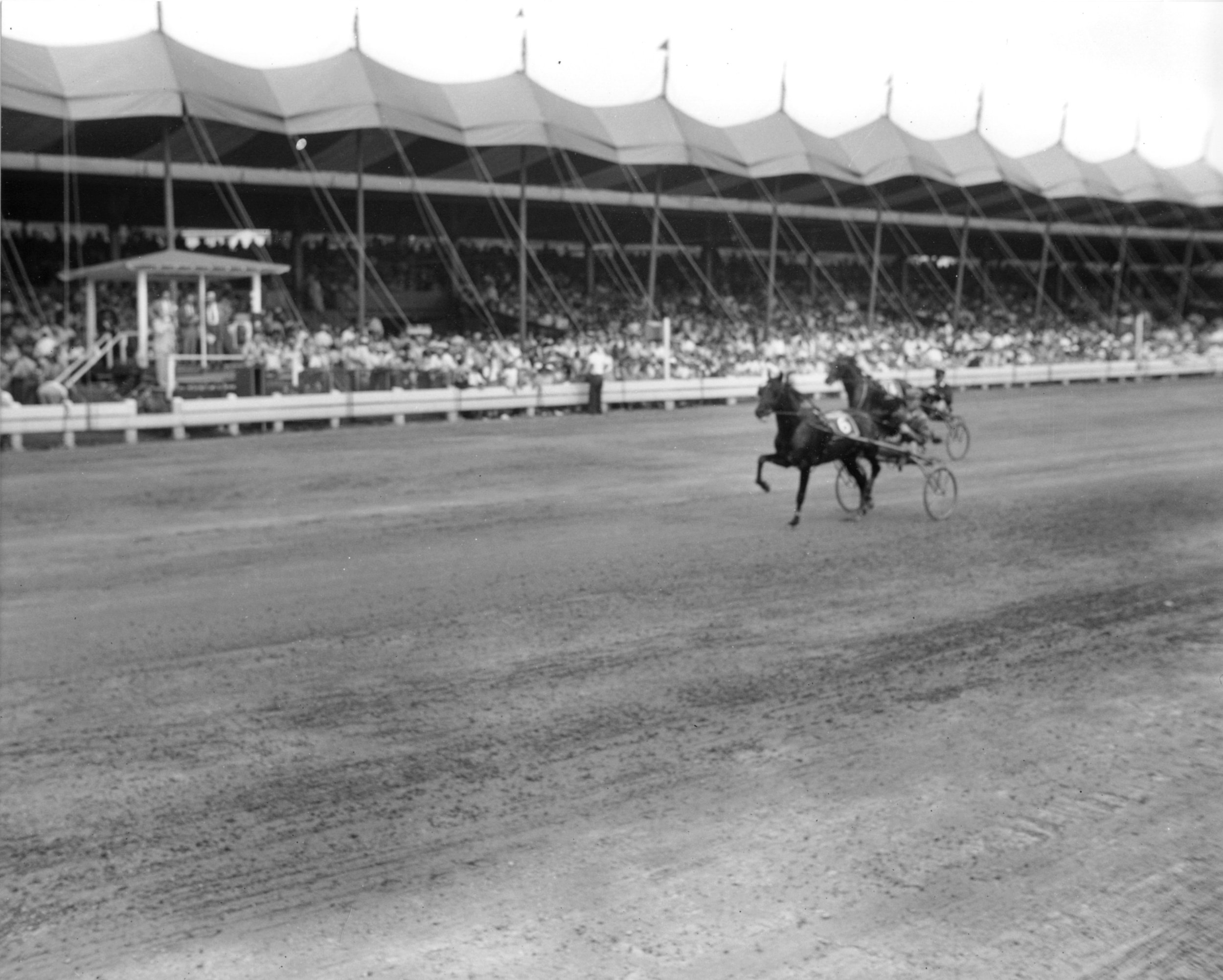
The Old + The New
august 7, 1952
goshen, ny
good time park
Purse $87,637
At 74, Bion Shively, known as the Oklahoma Sage, became the oldest driver to win a Hambletonian when he accomplished the feat with Sharp Note in 1952 for owner C. W. Clark of Dearborn, Michigan. Sharp Note, a $1,000 yearling purchase from the Walnut Hall Farm 1950 consignment, was lightly-raced at two. As in the previous year, showers caused the 1952 Hambletonian to be delayed from Wednesday to Thursday. It was nearly 4 p.m. when the field of 16 went to post. Sharp Note was off poorly on a break in the first heat and finished a distant 10th as Hit Song won by half a length over the favored Duke of Lullwater. In the second heat, Sharp Note stormed around the field and won easily. Leaving from the pole in the final heat, Sharp Note took charge at the three-quarter pole, coasting home to a two-length victory over Hit Song in 2:03.2.
At age 74, Shively was the oldest driver to win the Hambletonian. Bi Shively’s story was documented in the movie short, Old Man in a Hurry. Shively was a veteran of the Spanish American War. In a remarkable conditioning job, Sharp Note had not raced in almost three months before the Hambletonian. Sharp Note was the Three-year-old Trotter of the Year in the harness writers’ first divisional balloting.
Media
Champions |1950-1959

Records Galore
august 12, 1953
goshen, ny
good time park
Purse $117,17
A slew of firsts marked the filly Helicopter’s victory in the 1953 Hambletonian. J. Elgin and C. E. Armstrong of Brampton, Ontario, were the first Canadian owners to win the trotting classic; Helicopter’s sire Hoot Mon (1947 Hambletonian winner) was the first winner to sire a winner; Harry Harvey, at 29, was the youngest winning driver at the time; the total first place money of $53,126.59 was the most won in a single season by a three-year-old trotting filly, and the total purse of $117,117.98 (including breeders’ awards) was the largest to date. Helicopter’s 17th place finish after breaking in the first heat didn’t suggest that the filly would have much of a chance. Morse Hanover captured the first contest. In the next two, however, Helicopter was victorious, holding off stablemate Singing Sword with Delvin Miller in one and Kimberly Kid with Tom Berry in the other. Helicopter, so named because Mrs. Frances Van Lennep used a helicopter from her Castleton Farm to deliver a baby in a Lexington hospital when winter storms closed the roads, was retired to Armstrong Farm. She is the dam of Armbro Flight, who won a heat of the 1965 Hambletonian. Armbro Flight, in turn, is the dam of 1988 Hambletonian winner Armbro Goal.
First $100,000 purse in the Hambletonian. The largest field to ever start in the Hambletonian – 23 – consisted of two tiers and three more trailers in the third tier. Helicopter’s dam, Tronia Hanover, was bred by Hanover Shoe Farms and sold privately as a yearling because of a winged foot for $50 to Richard Hoke. Helicopter was sold as a weanling named Bell-Ard Monia at Harrisburg in November 1950 and was purchased by Castleton Farm for $1,150. She was the first foal by Hoot Mon (1947) ever sold at auction. Renamed Helicopter, she changed hands again the next fall in Castleton’s yearling consignment at Lexington. She was purchased by Delvin Miller and John Simpson Sr. for $2,000. First Canadian-owned winner of the Hambletonian and the first stake winner owned by the Armstrong Brothers, Helicopter was purchased privately from Miller and Simpson for $9,200 as a two year old ($7,500 plus an additional $1,700 based on her two-year-old earnings). She, along with Dottie’s Pick on the pacing side, became a foundation broodmare of one of the sport’s most extraordinarily successful racing dynasties. Miller’s assistant, 29-year-old Harry Harvey, was the youngest driver to that date to win the Hambletonian. Hoot Mon became: 1.) the first winner to sire a winner; 2.) the first stallion to sire a Hambletonian winner from his first crop; and 3.) the youngest stallion (as a five year old in 1949) to sire a winner to that date. Jimmy Wingfield, who came to prominence in the sport as the caretaker for the great Greyhound, won the first heat driving Morse Hanover.
Media
Champions |1950-1959

The Comeback
august 4, 1954
goshen, ny
good time park
Purse $106,830
The champion two-year-old the previous year, Newport Dream had been lame in the spring of 1954. But when the Axomite colt, owned by Octave Blake and trained by Del Cameron, got to Goshen, he was ready for the Hambletonian. In the first heat, Newport Dream trailed in eighth position to the half and used a burst of speed to take the lead for a three-lenth victory in 2:024. He won the second heat in the same time, rallying to catch Harlan in the final strides of a tight four-horse finish. For Grand Circuit President Blake, his first Hambletonian victory came after favored Newport Star, full brother to Newport Dream, failed in the 1953 Hambletonian. Early in 1955, Blake’s Hambletonian trophy was washed out of his Cape Cod home by a hurricane and was found a few days later nestled in the sand near the cottage.
Newport Dream was the first USHWA/USTA Two-Year-Old trotter of the year (1953) to win the Hambletonian, a feat repeated only 14 more times. The Hambletonian trophy was lost in a hurricane that swept through Cape Cod during the following year, destroying the beach home of owner Octave Blake. Several days later, the trophy along with its base was discovered in the sand where it had washed up on the beach.
Media
Champions |1950-1959
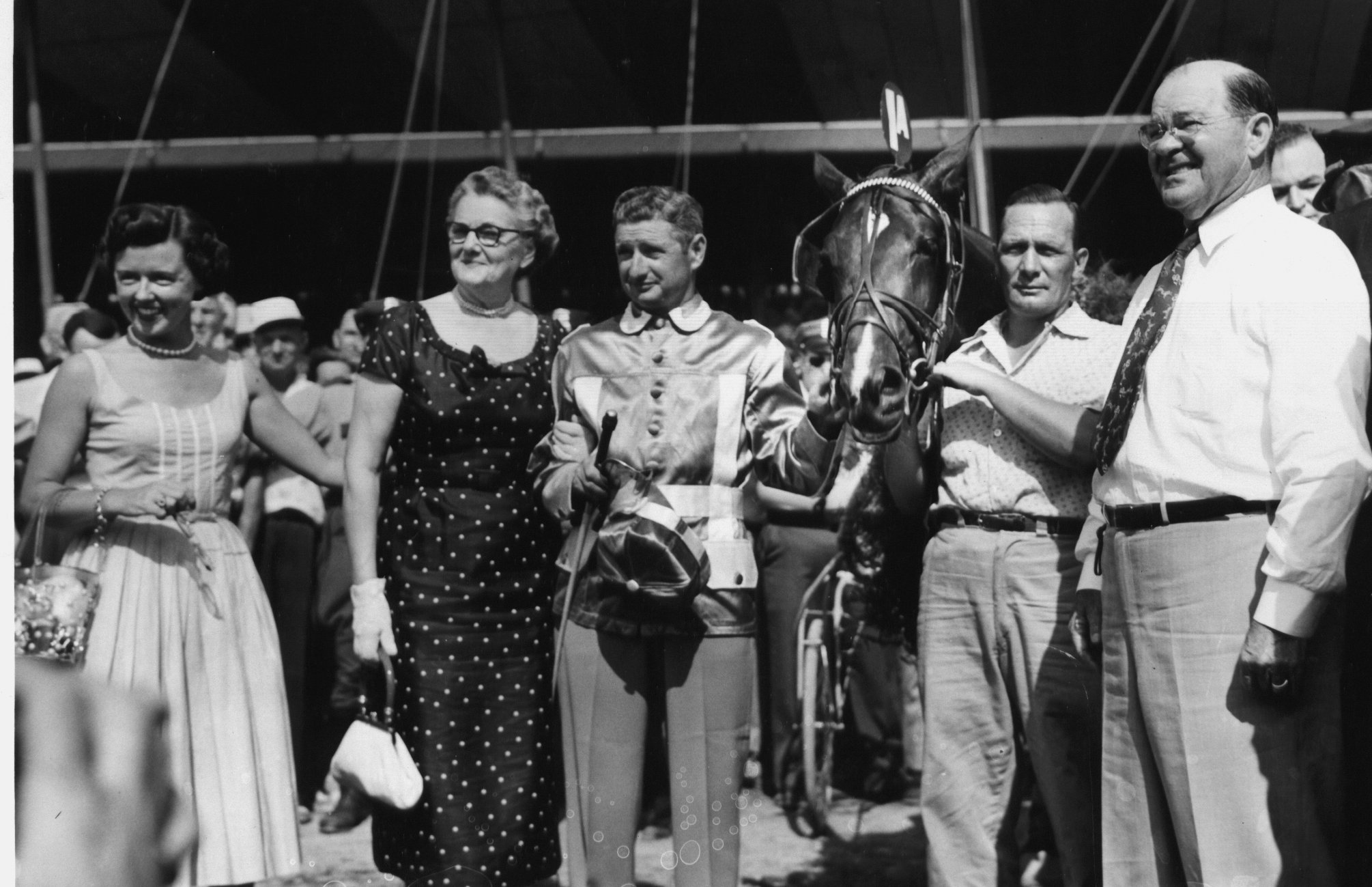
The Champ Comes Through
august 3, 1955
goshen, ny
good time park
Purse $86,863.32
Seldom has there been as much of a solid favorite for the Hambletonian as Scott Frost. Joe O’Brien’s star pupil, owned by S. A. Camp of Shafter, California, lived up to his billing in the Hambletonian tuneups. The son of Hoot Mon and Nora was unbeaten in his three-year-old form when he paraded to post for the Hambletonian. His first race had taken four heats at Historic Track. Trainer O’Brien, always known for his guarded pessimism, was far from happy about the prospects on race day. The brilliant colt had worked poorly in his final prep and the condition of the track just didn’t suit the long striding favorite. The first favorite to win since Demon Hanover in 1948, Scott Frost forged home in 2:013 and back in 2:003. Only his sire, Hoot Mon had trotted faster (2:00) to that point. The two heat total was the best on record for the event, displacing the 2:01½-2:01¾ duet set by Shirley Hanover. In the first heat, stablemate Butch Hanover shoved his head past Scott Frost at the third pole, but Scott Frost turned for home on top. It looked like a breeze until the last sixteenth when John Simpson fired up Leopold Hanover for a sizzling sprint, forcing Joe O’Brien to shake his colt up to win by half a length. The second mile, Scott Frost had the lead at the three-quarters. Billy Haughton behind Galophone made his bid an eighth from home and the pair engaged in a head and head duel. Fifty feet out it looked as if Galophone might snatch the decision but Scott Frost hung on and won by a head. Scott Frost’s dam, Nora, was purchased by Roy Amos of Frost Hill Farm, Edinburg, Indiana at the W. N. Reynolds dispersal sale at Harrisburg. Scott Frost was foaled on his property and raised at the Hoosier farm. An all-time great, Scott Frost followed up on his Hambletonian win with victories in the Yonkers Futurity and the Kentucky Futurity. Back on his home ground in California, the bay colt blazed to a 1:592 triumph over the best aged trotters. Not only did Scott Frost win more money than any other horse in a single season, the Camp headliner took over the leading money winning stallion title. Only the first four finishers received checks (60% - 25% - 10% - 5%)
A winner of 23 of 28 starts at three, Hambletonian day was one of the few times that Scott Frost did not dominate his peers. After winning a tough three-heat stake at Vernon Downs that concluded at midnight just five days before the Hambletonian, Scott Frost was tested to the limit in the straight heats, first by Leopold Hanover and then by Galophone. Accounts of both heats give much of the credit to O’Brien’s reinsmanship. O’Brien modestly attributed the victory to courage on the part of his trotter. Scott Frost captured the first Triple Crown of Trotting in its initial year when he won the Kentucky Futurity and the very first edition of the Yonkers Trot. The publicity department of Yonkers apparently first applied the "Triple Crown" designation. It appeared in their year-end wrap up in the trades and was included the following year in the 1956 U.S.T.A. Trotting & Pacing Guide. The first three-year-old trotter to record more than one 2:00 mile (3), Scott Frost was selected Horse of the Year by the harness writers.
Media
Champions |1950-1959
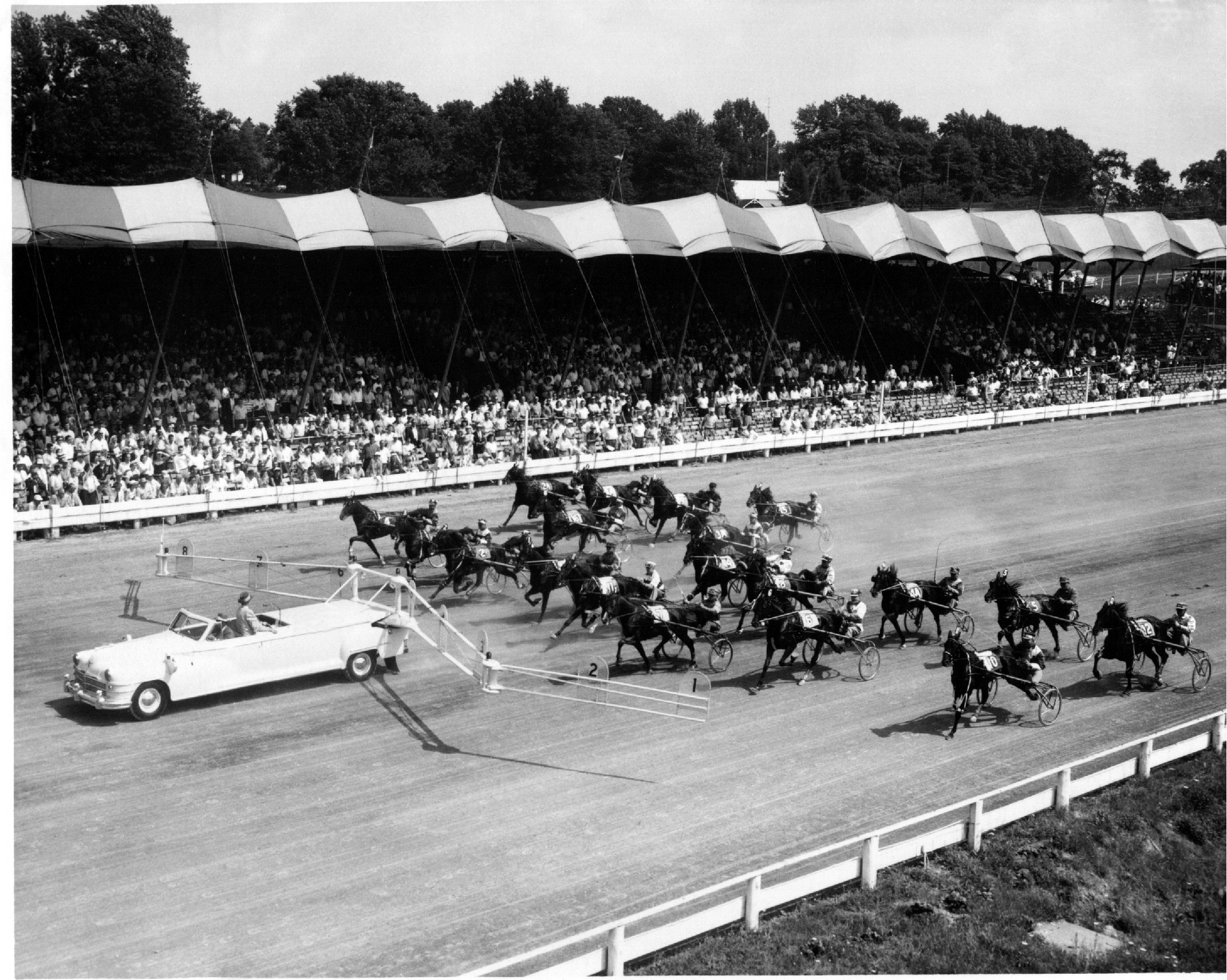
Bower wins Hambletonian Debut
august 8, 1956
goshen, ny
good time park
Purse $98,591.91
The Intruder, owned by the Allwood Stable of Far Hills, New Jersey, captured the 31st Hambletonian, and the final one at Goshen’s Good Time Park. In an exciting three heat duel, driver/trainer Ned Bower became the second youngest man to win the big race in his first Hambletonian appearance. Bower, just shy of 33, swept the final two heats after finishing seventh in the first heat, which was won by Valiant Rodney. In the initial heat, The Intruder had second tier 11 post and was forced into a break when Dial Tone, on the rail, made a break. Meanwhile, Valiant Rodney stormed through the stretch to beat Moray, who made a break at the wire. Moray was later placed fourth. In the next heat, favored Egyptian Princess, given some sharp handling by Earle Avery, reached the lead and cut fractions until the three-quarter mark. The Intruder was ninth at the quarter, tenth at the half, and 15th at the three-quarter mark. But he rallied to win the heat by a half a length. In the final, Egyptian Princess again cut the mile while The Intruder remained off the pace, seventh at the half and three-quarters. But Bower got his charge rolling shortly thereafter and won going away by three-quarters of a length. The Intruder was the fifth performer by the stallion Scotland to win the famed classic, joining Rosalind (1936), Spencer Scott (1940), The Ambassador (1942) and Hoot Mon (1947).
After the death of Mr. Cane in 1955, his widow and the management of Yonkers Raceway, which would eventually purchase Good Time Park, hosted the Hambletonian one last time at Goshen. An unraced two-year-old, The Intruder won only two of seven starts at three (both overnight races, the fastest in 2:07 on a half-mile track) before the Hambletonian. Owner Leonard Buck was persuaded to enter his horse at the last minute by racing writers Elizabeth Rorty and Frances Wallace after the colt worked two miles with fast last halves (58 seconds) – perfect for the bulky 20 horse field. A Hambletonian that produced several longshot winners, Mrs. David R. Johnston’s Valiant Rodney won the first heat and paid $60.30 for $2.00. The Intruder was eleventh. The Intruder won the next two heats, paying $26.80 and $10.90 respectively. He was the highest priced winner ever in a final heat. The favorite in all three heats was Clearview Stable’s Egyptian Princess (14-2-4), owned by Norman Woolworth, and his brother Fred. Woolworth has continued his ownership of top quality stakes winners through an amazing five decades. He did have to wait 17 years to win the Hambletonian — with another filly, Duenna (1983). Woolworth and the Johnstons eventually became partners in Stoner Creek Stud. The Intruder was the eighth Hambletonian winner bred by Walnut Hall Farm, a record at the time. He was also the 14th sired by a Walnut Hall stallion, also a record at the time. He was the last of five winners by Scotland who was 26 at the time of the mating. Ego Hanover, who was pacing at the finish of the final heat, went unnoticed by the judges. Fifth in the summary overall, the incident did not affect Ego Hanover since only four monies were paid that year.
Media
Champions |1950-1959

DuQuoin’s Debut
august 27, 1957
DuQuoin, IL
DuQuoin State Fair
Purse $111,126
The Hambletonian was in its first year at a new home, the DuQuoin State Fair, and 21 starters paid the freight for their shot at the trophy. The large field was divided into two divisions with each group racing two heats and the winners returning for a fifth and final heat. One of the favorites, the Sheppard and Mudge-owned Hickory Smoke, took the heats of the first division in 2:01 and 2:00 1 for John Simpson Sr. The Hoot Mon filly, Hoot Song, took both heats of the second division for Ralph Baldwin and Two Gaits Farm of Indiana in 2:02 1 and 2:02. The final belonged to Hickory Smoke, who trotted the final quarter of his 2:08 4 mile in 28.3 to hold off a fast closing Hoot Song. Of note in the field of starters was Charlotte Sheppard’s Cassin Hanover, who as a broodmare later produced Elma to the cover of Hickory Smoke. Elma went on to win $164,710 in a successful American and European career. As a broodmare, Elma produced Japa, at one time the world record holder for three-year-old trotting fillies, and Texas, runnerup to Green Speed in the world record 1:55 3 Hambletonian in 1977. Finishing third in both heats behind second division winner Hoot Song was the young Rodney stallion,Speedster, who later would sire two Hambletonian winners, full brothers Speedy Scot and Speedy Streak. Also of note in the 1957 field was the 10-6 finish of Flicka Frost, driven by William Haughton. Flicka would later earn a niche in the history of the Hambletonian as the dam of two winners, Timothy T. in 1970 and Chris-topher T. in 1974.
The Hambletonian was moved to DuQuoin, Illinois from Good Time Park in Goshen, NY, - prompted by a dispute between the United States Trotting Association and New York State racing officials. In a statement issued by Hambletonian Society president E. Roland Harriman, "The directors of the Hambletonian Society were agreed that the proper place for the Hambletonian is Goshen. (First raced there in 1930 and every year since except 1943.) However, in view of the unsatisfactory conditions under which harness racing is being administered at the present time in New York State, a contract was awarded for two years to the DuQuoin State Fair, DuQuoin, IL, by unanimous vote." The race stayed at DuQuoin for 24 years. Becuase of the 21 starters, the classic was conducted in an elimination format with two divisions, each racing two heats. Hickory Smoke won both his heats and then defeated Hoot Song in the final race-off between the two. He was the only horse ever required to win three heats to take home the Hambletonian trophy. The only horse ever to win two heats of the Hambletonian but not the trophy was the filly Hoot Song. She won both her divisional heats, but lost the Hambletonian in the third heat race-off, thereby finishing second in the summary. No wagering on the race at DuQuoin until 1975. DuQuoin's Hambletonian Song is written and performed for the first time by Leah Hayes.
Media
Champions |1950-1959
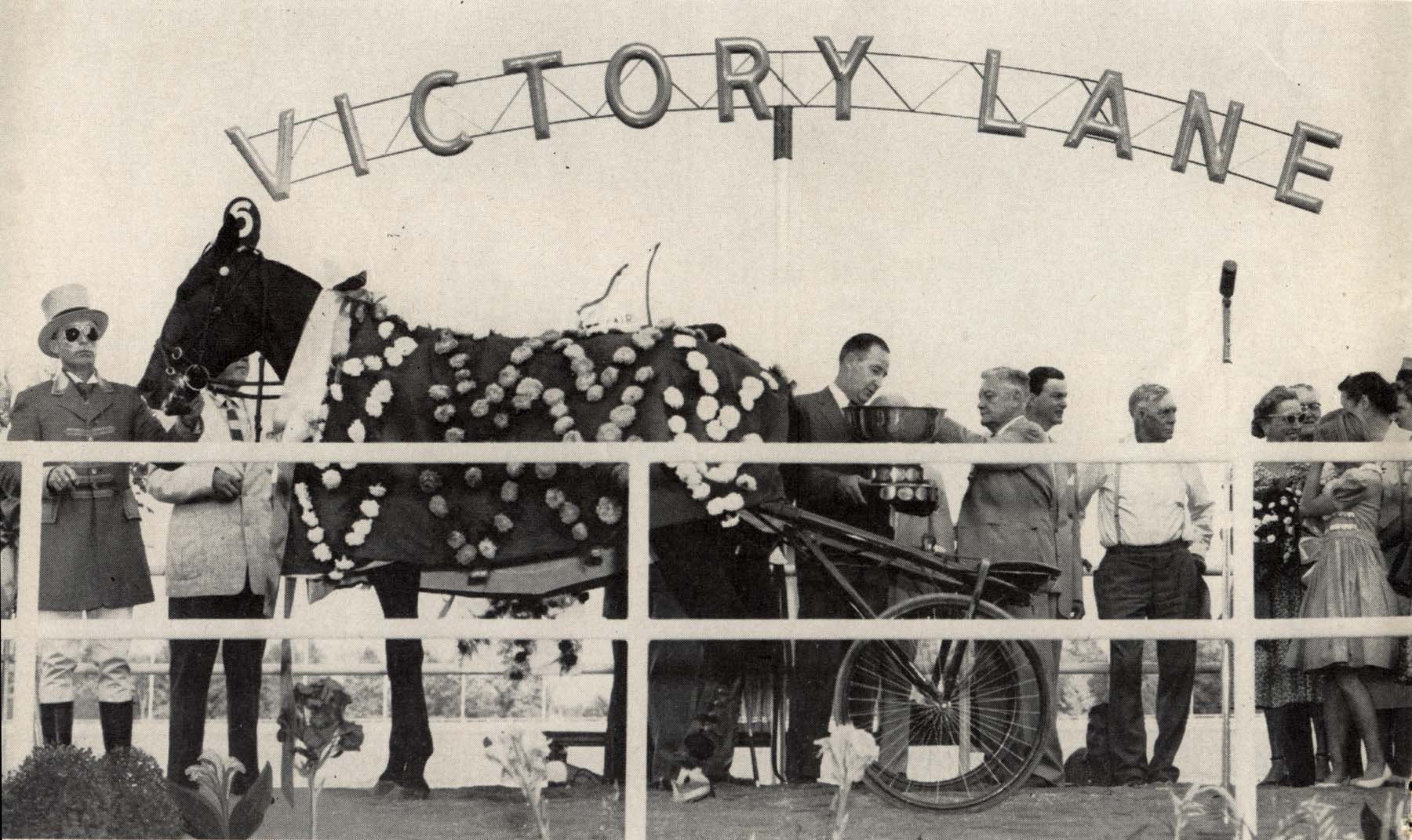
The Star’s Pride Era Begins
august 27, 1958
DuQuoin, IL
DuQuoin State Fair
Purse $106,719
The three-heat victory of Emily’s Pride was the beginning of a new Hambletonian era — that of the domination of Victory Lane at DuQuoin by sons and daughters of Star’s Pride. Bred by the noted Connecticut breeder Charles W. Phellis, Emily’s Pride was owned by Castleton Farm and Walnut Hall Farm of Lexington, Kentucky and was driven by “Flick” Nipe for trainer Fred Egan. Emily’s Pride won her first heat in 2:00 1 , beating Mr. Saunders and Gene Riegle, and Sharpshooter, driven by Harry Pownall. She was 12th in the second heat after going offstride on the backstretch. Fred Egan recaptured her form in the third heat, trotting past second dash winner Little Rocky and Joe O’Brien in a beautiful 1:59 4 mile, which at the time was the fastest mile trotting in this stake. The new stake mark did not come easily as Emily’s Pride had to circle the field from the 12th post position and was still parked on the outside past the half in :59 3 . Nearing the three-quarters, trotted in 1:29 3 , Nipe asked the filly to trot again and she zoomed into command and held off the close of Sandalwood and Ralph Baldwin.
First Hambletonian faster than 2:00; the mile in 1:59.4 was a world record for a three-year-old filly trotter. Fred Egan, 79, was the oldest trainer ever to win the hambletonian; it was his third. Egan referred to his driver, 62-year-old Flave "Flick" Nipe, as "that boy!" The previous year Egan had driven Cassin Hanover to a 3-3 finish. At 70 years of age, he won the Hambletonian driving Miss Tilly (1949). Egan was certain he had the 1958 Hambletonian winner in his barn all along, but he was focusing on Gang Awa, another trotter he had initially trained for C.W. Phellis, the breeder and original owner of Emily's Pride. Gang Awa was the offspring of two Hambletonian winners, Hoot Mon (1947) and Miss Tilly (1949), but only finished 6-13-8 that day. Both Gang Awa and Emily's Pride had been initially trained by Egan for Phellis and remained in his stable when they were sold to Walnut Hall Farm and Castleton Farm privately after Phellis' death. Emily's Pride was the dame of Noble Victory, the favorite for the 1965 Hambletonian. Emily's Pride was voted Horse of the Year.
Media
Champions |1950-1959
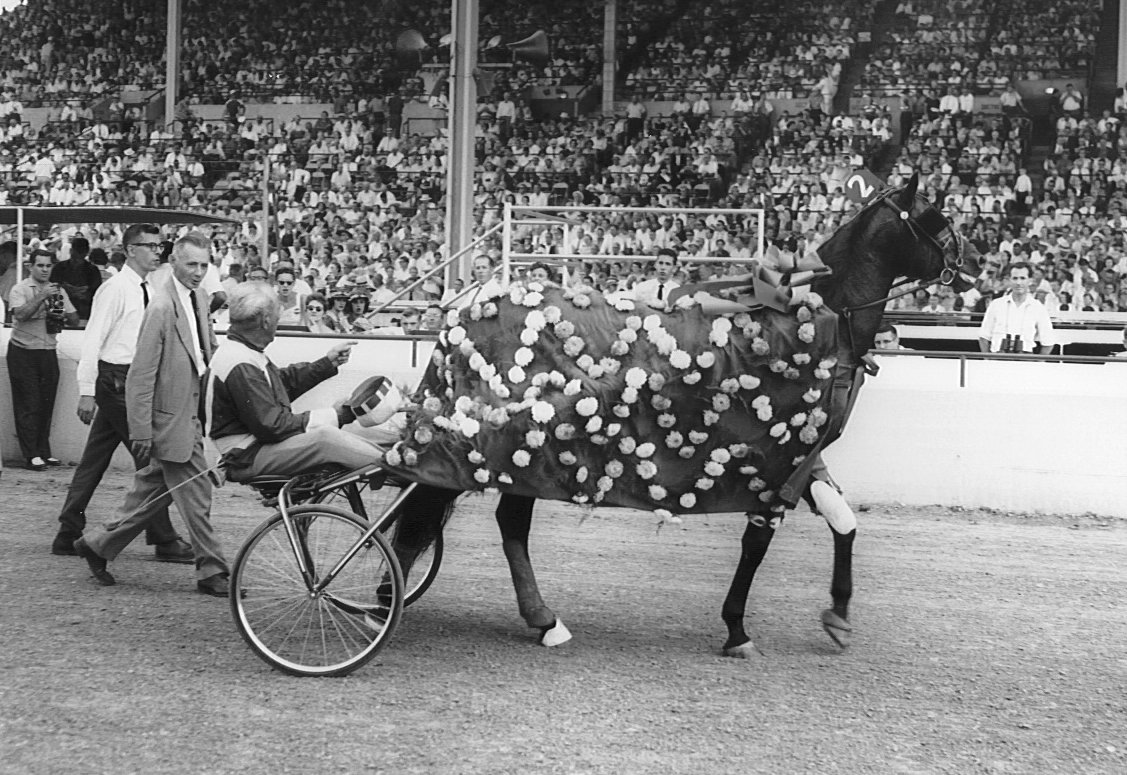
Baldwin Finishes 1-2
September 2, 1959
DuQuoin, IL
DuQuoin State Fair
Purse $125,283
As has often happened in Hambletonian history, a trainer of two colts entered in the great race has chosen one of his two possible mounts and given the other drive to a friend, and then watched as that friend drove his way to victory lane. Such was the case in 1959 when Ralph Baldwin gave the drive behind Diller Hanover to Frank Ervin, who would gain his first Hambletonian victory in ten tries. Diller Hanover, a son of Star's Pride, rewarded his young sire with his second straight Hambletonian winner with miles in 2:01.1 and 2:01.4 over a track dulled by rain a day earlier. Ralph Baldwin trained Diller and prepped him for the race, but chose instead to drive Tie Silk, who finished second fourth with Circo and Bill Haughton trotting home second in the final heat, but not menacing the winner. The purse was a record $125, 283, at the time the richest harness race ever, and the winner's share of $73,666 made Diller Hanover the leading money winning two-and three-year-old of all time in harness racing.
Frank Ervin catch-drove for trainer Ralph Baldwin, who reined the other half of his entry, Tie Silk, and finished second in the summear (2-4). Diller Hanover was the Three-year-old Trotter of the Year. The youngest driver ever in the Hambletonian, future Chicago star Walter "Butch" Paisley, was only 18 years and six months old when he drove Algiers Eblis, a horse owned by his father, to a 12-15 finish, 14th in the summary.
Media
Champions |1950-1959



